4 Volumes
Regional Overview: The Sights of the City, Loosely Defined
Philadelphia,defined here as the Quaker region of three formerly Quaker states, contains an astonishing number of interesting places to visit. Three centuries of history leave their marks everywhere. Begin by understanding that William Penn was the largest private landholder in history, and he owned all of it.
Philadephia: America's Capital, 1774-1800
The Continental Congress met in Philadelphia from 1774 to 1788. Next, the new republic had its capital here from 1790 to 1800. Thoroughly Quaker Philadelphia was in the center of the founding twenty-five years when, and where, the enduring political institutions of America emerged.
Haddonfield, New Jersey
Haddonfield is now well past its three hundredth birthday.
Haddonfield (all 26)(1 of1)volume 38
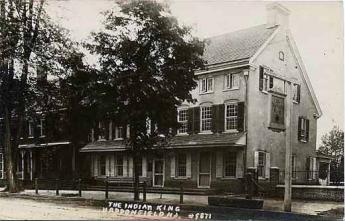 Haddonfield is a bit of a secret. It's Philadelphia's "Main Line, East"
Haddonfield is a bit of a secret. It's Philadelphia's "Main Line, East"
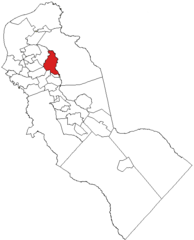
|
| Map of Camden County, NJ |
Haddonfield sits right on the PATCO High Speed Line into Philadelphia. It's an 11 minute trip every 15 minutes, so it's perfectly convenient for commuting and culture. Haddonfield has blocks and blocks of magnificent houses dating from before the Revolution to the present, with Queen Victoria's era well represented.
Founded by the Quaker Elizabeth Haddon shortly after her arrival from England in 1701. The Quaker meeting continues in operation to this day and Haddonfield Friends School has taught hundreds of students over the years. That's sort of one town, and it seldom goes to Philadelphia. The second Haddonfield amounts to Camden suburbs, rapidly dwindling. And the third social level of Haddonfield is composed of Philadelphia commuters, who cross the River almost every day. These three groups mix together very seldom except to use the shops, churches, and schools.
The Origins of Haddonfield

|
| Haddonfield's Dragon |
Haddonfield, New Jersey is named after Elizabeth Haddon, a teenaged Quaker girl who came alone to the proprietorship of West Jersey in 1701 to look after some land which her father had bought from William Penn. Geographically, the land was on what later came to be called the Cooper River, and it must have been a scary place among the woods and Indians for a single girl to set up housekeeping. It was related in the "Tales of a Wayside Inn" that Elizabeth proposed to another young Quaker named John Estaugh. Because no children resulted, she sent to her sister in Ireland to send one of her kids, a girl who proved unsatisfactory. So the kid was sent back, and Ebenezer Hopkins was sent in her place. Thus we have Hopkins pond, and lots of Hopkins in the neighborhood ever since. Eventually, the first dinosaur skeleton was discovered in the blue clay around Hopkins Pond, and now can be seen in the American Museum of Natural History, so you know for sure that Haddonfield is an old place. Eventually, the Kings Highway was built from Philadelphia to New York (actually Salem to Burlington at first) and it crosses the Cooper Creek near the old firehouse in Haddonfield, which claims to house the oldest volunteer fire company in America, but not without some argument about what was first, what is continuous, and therefore what is oldest. Haddonfield is, in short, where the Kings Highway crosses the Cooper, about seven miles east of City Hall in Philadelphia. The presence of the Delaware River in between makes a powerful difference since at exactly the same distance to the west of City Hall, is the crowded shopping and transportation hub at 69th and Market Street. Fifty years ago, Haddonfield was a little country town surrounded by pastures, and seventy years ago the streets were mostly unpaved. The isolation of Haddonfield was created by the river and was ended by the building of the Benjamin Franklin Bridge in 1926. If you go way back to the Revolutionary War, the river created a military barrier, and many famous patriots like Marquis de Lafayette, Dolley Madison, Anthony Wayne and others met in comparative safety from the British in the Indian King Tavern. In a famous escapade, "Mad" Anthony Wayne drove some cattle from South Jersey around Haddonfield to the falls (rapids) at Trenton, and then over the back roads to Washington's encampment at Valley Forge. In retaliation, the British under Col John Simcoe rode into nearby Salem County and massacred the farmers at Hancock's Bridge who had provided the cattle. At another time, the Hessians were dispatched through Haddonfield to come upon the Delaware River fortifications at Red Bluff from the rear. Unfortunately for them, they encamped in Haddonfield overnight, and a runner took off through the woods to warn the rebels at Red Bank to turn their cannons around to ambush the attackers from the rear, who were therefore repulsed with great losses. These stories are told with great relish, but my mother in law found out some background truths. Seeking to join the Daughters of the Revolution in Haddonfield, she was privately told that the really preferable ladies' the club was the Colonial Dames. Quaker Haddonfield, you see, had been mostly Tory.
|
||
| Alfred Driscoll |
A local boy named Alfred Driscoll became Governor of New Jersey, but before he did that he was mayor of Haddonfield. He had gone to Princeton and wanted to know why Haddonfield couldn't look like Princeton. All it seemed to take was a few zoning ordinances, and today it might fairly be claimed that Haddonfield is at least as charming and beautiful as Princeton, maybe nicer. At the very least, it has less auto traffic. Al Driscoll went on to be CEO of a Fortune 500 pharmaceutical corporation, and everyone agrees he was the world's nicest guy. The other necessary component of beautiful colonial Haddonfield was a fierce old lady who was married to a lawyer. Any infraction of Al's zoning ordinances was met with an instant attack, legal, verbal, and physical. A street-side hot dog vendor set up his cart on Kings Highway at one time, and the lady came out and kicked it over. If you didn't think she meant business, there was always her lawyer husband to explain things to you. She probably carried things a little too far, and one resident was driven to the point of painting his whole house a brilliant lavender, just to demonstrate the concept of freedom. Now that she and her husband are gone, the town continues to be authentic and pretty, probably because dozens of other citizens stand quietly ready to employ some of her techniques if the need arises.
Camden NJ: The Third, or Irish, Tenth
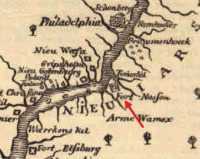
|
| Camden in 1662 |
The early Swedish and Dutch settlers tended to sail up the Delaware Bay, and settle on the right-hand bank, which we now call New Jersey. In time, Seventeenth-century settlers, even William Penn, switched over to the left, or Pennsylvania, side. The Dutch, who had experience with dikes on the Zuider Zee, knew that it was quicker and easier to drain the lowlands than to chop down big trees and dig up the roots. Although the Dutch were more interested in fur trading than agriculture, they had to eat. Fish, crabs, oysters and truck gardens were enough for that purpose. After establishing a Fort Nassau at what is now the town of Gloucester, on the south edge of Camden, fur trading on the New Jersey side began to fall off, and the Dutch settlement was moved across the river as Fort Casimir, next to the mouth of the hidden river, the Schuylkill, just south of what is now the international airport. That was fine for the Dutch to stay close to their ships, but the Indians on the far side of the swamp resisted coming down the swampy river and held back to do their fur trading at Gray's Landing, on the high ground between Bartram's Gardens and the University of Pennsylvania. For the Dutch it was a pleasant paddle up from the mouth of the river at Fort Casimir, and anyway you never know about strangers.
William Penn followed the same path, buying and reselling farmland in New Jersey for a decade before he asked for, and King Charles gave him, Pennsylvania. Skipping many of the details, northern New Jersey, called East Jersey, was given to Scottish Quakers, while what we call South Jersey and they called West Jersey, was divided into ten parts among the English Quakers. The Third Tenth around the Cooper River roughly corresponds to Camden County, and was mainly purchased by Irish Quakers and for a while was called the "Irish Tenth". In time, Gloucester County was split off from Camden County, which was mainly known originally as Newton Township. After a century, the Irish origins of the local inhabitants of Newton and Haddonfield were largely forgotten. The town of Gloucester, however, was situated on the river next to what was to be the vast shipyards of New York Shipbuilding Corp.(1899-1967). First addressing the oak forests of West Jersey for the masts of sailing ships, sailing ships were built with lumber logs floated down the Susquehanna River in rafts during the Nineteenth century. This industry attracted later Irish immigrants during the time of the great Irish migrations, and still more were attracted when World War I made Camden a major steamship building center. The experience was repeated during World War II, reaching its eventual high point when the nuclear Aircraft carrier Eisenhower could be seen under construction by commuters going over the Walt Whitman Bridge.
Shipbuilding, like other heavy industry of the rust belt, moved abroad seeking cheaper labor, and what little remained on American soil moved to Norfolk, Virginia. The response of protectionist legislation made America even less attractive for unionized industry. The wiser workers saw what was happening and sought jobs in other industries, elsewhere. But Gloucester City, underneath the bridge girders and surrounded by winding creeks, held out as an oasis of working-class Irish as the southern anchor of crumbling, decaying Camden. About a thousand homes had been built by the federal government during the labor shortages of World War I, as Fairview. These two little Irish enclaves, 97% Caucasian, continue to hold out for a day that will likely never return, gathering in their taverns to sing songs about old martyrs, fighting to maintain control of the industrial unions, and dominating the Democrat politics of the county. There was a time when leverage might have established political control of South Jersey, and through that to the domination of the whole state, but that gets progressively less likely. Tough politics essentially met more than its match in the river towns of North Jersey, other groups learned to play the ethnic game, and the recent uproar about child molestation has loosened the hold of their church on young adherents with school children. The same pattern seems to be emerging on the Pennsylvania side of the river in Delaware County, where however the political machine has historically been Republican.
Meanwhile, just a little to the north, the city of Camden steadily decays and deteriorates. Now only half the size of its 125,000 "Citadel of Republicanism" in 1950, the title of America's poorest city is applied to an average income of $18,000, and various statistics of violent crime make it the first or second most dangerous place in America to live. The City is 53% black, 29% of Puerto Rican origin, and 44% below the official poverty level. In 2001, its Mayor was sent to jail as an affiliate of the Mafia, and the state took over the running of the city. In 2009, a state auditor reported that the books were in such chaotic condition that it was impossible to say where they stood, financially. Along the way to this sorry state, RCA Victor (1901-1986) finally moved out, after decades of watching its employees migrate to the suburbs, taking their tax revenue with them. Although Campbell Soup loyally maintains and is even expanding its national headquarters in Camden, the soup is made elsewhere. Frozen chicken dinners are made by the hundreds of thousands in Delaware, assembling the tinfoil, chickens, and peas from hundreds of miles to the moment when it is packaged mechanically in a manner that would shame the Japanese. There was a time in living memory when truckloads of Jersey tomatoes were lined up at the Camden soup factory for miles, but all that has moved to California. Jersey tomatoes ripened sequentially throughout the season, requiring human tomato pickers to tell green ones from red ones. A new form of hybrid tomato ripens all the fruit simultaneously, allowing it to be mechanically harvested, and taking advantage of three crops a year in California. The Golden State on our western coast seems to be having labor and tax trouble, too; but that is small comfort to Camden.
As factories close, people abandon their homes, slums result. The schools deteriorate, migration and crime increase. Most people would say it is a mess. A recent sociological study, called Camden After the Fall describes in painful detail how every idea anyone has ever had about how to turn Camden around -- has been tried, amply funded and found to be an utter and discouraging failure. The highway system has been modernized, only to allow commuters to buzz through Camden somewhat faster. Public buildings have been built, only to underline the fact that no new construction has taken place with private money in decades. Building a prison in the center of town created jobs, and now more jobs are being created to tear it down. Rutgers, the state university, has a branch under the shadow of the Ben Franklin Bridge. The battleship New Jersey is at anchor in a lovely riverside park, there's a nice little minor league baseball park. Anything you can build with tax money has been built. There's just no private industry, or business, or profession. Anyone who has a bright idea is welcome to read Camden After the Fall . It's just possible something to try has been overlooked, though it isn't very likely. Except for law, order and good schools.
After decades of watching Camden get steadily worse as I commuted hastily through it, I would say there actually is sort of a plan visible. As houses decay, they are torn down, and the grass is planted. It seems likely that the plan is to wait until a large enough plot of land is cleared and planted to grass, so it eventually becomes attractive to a developer. And then the developer will make tons of money with raw land that even the Indians in 1640 could see was very well situated.
Railroading Haddonfield
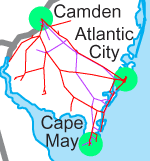
|
| Haddonfield Map |
For a century or more, Haddonfield has had a railroad. Both the Reading and the Pennsylvania railroads ran through Haddonfield on their way from Philadelphia to Atlantic City, and later on, they were combined in the Pennsylvania-Reading Seashore Line. In 1950, the coal-fired steam locomotives still made a grade crossing on Kings Highway and tooted at the outskirts of town. A little awkward, dirty and dangerous, perhaps, but it had to be admitted that regular train service to the Shore was nice, as was regular commuting to Philadelphia. At least once a day, an elegant old train named the Nelly Bly made a round trip to New York, for those who occasionally wanted to take in a show, or do Christmas shopping in style. From the looks of some of the larger Victorian houses in town, there might even have been a few bankers going to Wall Street for important matters. Haddonfield was sleepy, but it had made things very convenient for itself.
And then, around 1970 the price of Haddonfield real estate tripled overnight. The Delaware Port Authority announced its plans for PATCO, a high-speed regular subway-surface line. Now that it is in existence, we have clean comfortable safe trains every seven minutes to the Center of Philadelphia. The express trains used to take eight minutes to Philadelphia, but now we only have locals who take twelve minutes. The main complaint is that there is not quite enough time to read the newspaper.
There's a personal story here. In the articles about the coming high-speed line, I noticed two things: there was to be an elevated overhead track through Haddonfield, and the director of the Port Authority had been a West Point classmate of my uncle. Having spent four years in New York City, my image of an elevated train was highly unfavorable. They were noisy, and the noise created slums all along their path. Not what was wanted in tree-lined Haddonfield, at all. And the General, who among other things was a neighbor up my street a few houses, created a means to change the plans. We held a mass meeting in my house, and among those present was a former regular-Army major, who had been the track engineer for the Illinois Central. He said that he had been through such arguments many times, had usually beaten down the opposition, but as a matter of fact, putting the rail line below grade was perfectly feasible. With that, one thing led to another, and General Casey finally one day was heard to say, "All right, I'll do it. But don't tell Collingswood." Collingswood is two stops closer to Philadelphia, and the main point was that a very popular religious radio station was located a hundred yards from the proposed line. One day, the minister of this station woke up to see an elevated -- an elevated -- being built outside his window. You can imagine all the rest, the radio broadcasts, the protests, the confrontation. But unfortunately, it was too late to make a change of plans.
As an epilogue, it can now be seen that there would have been advantages to the original design. The trains from Philadelphia to Atlantic City run immediately alongside the tracks of the high-speed line for a mile in Haddonfield. If they weren't all squeezed in a ditch, there might have been room for an interchange between the two at Haddonfield. But we don't care, we don't care. When we want to go to the shore, or to New York, we will drive.
Norcross
It's a strange observation that many important Democratic politicians are members of family dynasties. Almost everyone knows of the Kennedy family of Boston, but there are many many more. One of them is the Norcross family of Camden County, New Jersey. You can devise your own theory why this is so, the most common being the Irish background of large families; but I have a different theory. It is that the 16th Century began the tradition that a "perpetuity" was only allowed to exist for "one lifetime plus 21 years", and this definition worked its way into English Common Law. That was not particularly hampering to the Rockefellers and Vanderbilts in the days before confiscatory taxes, but it was mightily favorable to those with tribal dominance, such as the Irish, who always had an extra son or two to pass along family secrets. The Irish spoke English, so they were the dominant immigrants in a flood of 19th Century newcomers. So this was the source of many priests and policemen, firemen -- and politicians intertwined. No one troubled to devise blockades against passing political tricks and strategies through the inheritance process, and indeed it may not be possible. But the Ford Family established its family dominance of car dealerships by unwritten promises, which were strictly enforced; so the idea may not even have had an Irish origin.
Camden was a city created by the Delaware River separating New York City from Philadelphia. The river was a terminus for the Camden and Perth Amboy RR, and the entire RR was contained within New Jersey. In those days, each new corporation had to have a law created for it, and this one granted the Camden and Amboy RR a perpetual right to be the sole railway in the state. Subsequently, the Camden and Amboy led to ferries across the River, which in turn connected to railroads from Philadelphia to the South. Here was the sense in which Camden/Philadelphia became the "most Southern of the Northern cities". Another way of looking at it was to became a little Chicago thriving on hotels and shopping between trains for Atlantic Coast travelers. Three main industries had their headquarters plus feeder suppliers there (New York Ship Building, RCA-Victor Phonograph, and Campbell Soup). When the Ben Franklin Bridge was built in 1926, the fundamental reason for Camden's existence disappeared. It took eighty years, but one by one the industries shuttered and went away, leaving transportation lines and empty buildings. At some time along the way, the Norcross family realized that location next to a big city would become valuable in time, and the family and allies bought it with money derived from the family insurance company for municipalities. It's now starting to sell off the location bit by bit, understanding it might take another century to realize the full value of the location. Even a century after the bridge-building, hardly any private building has taken place, and slums still occupy vast tracts of otherwise abandoned land. It has the highest murder rates in the nation and must subsist on political dealings for decades to come. Real estate developers can't normally live long enough to reap the full rewards, but a politically savvy family can wait it out to becoming billionaires. They would have to sustain many family quarrels, divorces, and egregious mistakes for this scenario not to play out.
How did the monopoly of the Camden and Amboy disappear? Well, I couldn't prove this in court, but in political circles, it is calmly believed that a man named Stanhope slipped a document breaking the monopoly in amongst a pile of papers for the Governor to sign obliviously. It was the same caper that sent William Penn (the richest private landholder in the world) to debtor's prison, a century or so earlier. The Norcross family surely had nothing to do with this story. Real estate is just a tough game. Anyway, the breaking of the monopoly was too far advanced to retreat. Bucks County had to be pacified in some way, so the 1858 City/County consolidation was arranged as a political reform, with the City of Philadelphia as the largest stockholder of the emerging Pennsylvania RR on the west side of the River. In 2000, Robert Montgomery of Ardrossan said he had no idea where his stock certificates came from, and even the mighty Pennsylvania Railroad has disappeared.
Tavistock
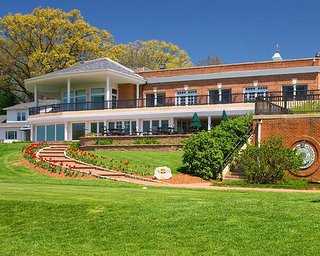
|
| Tavistock country club |
Right next to Haddonfield is another town called Tavistock. It contains four houses, quite large ones, and a perfectly beautiful country club. This geo-political curiosity came about only partly because Haddonfield is dry, no liquor. The present location was created during national Prohibition (of alcohol) when it didn't matter what the local option said. The really devastating local ordinance was a prohibition of playing golf on Sunday. It is probably correct that abolishing liquor is a good way to keep the town looking pristine, so that Haddonfield's continuing dryness had something to do with maintaining real estate values in addition to maintaining sobriety, in the minds of local property owners. This stance was certainly vindicated when a race track was built a mile or so away, and local residents could easily imagine all sorts of high life that might grow up in the shadow of a race course. Haddonfield learned what it thought was the lesson in this, and continues to prohibit alcohol sales (consumption is of course quite another matter) after the repeal of the Volstead Act. So Sam Fulton and the other founding fathers of Tavistock probably knew what they were doing. The existence of Tavistock is the best evidence of the shrewd thought processes in town because in some minds you can't have a country club without liquor. You also can't have much of a golf course without some hills, and hills like Tavistock are in short supply in southern New Jersey. Sam Fulton wanted the place neat and tidy; as Mayor of the four-house town, he passed an ordinance that the birds were required to fly upside down. The legal and political defenses of this oddment seem well planned and emotionally quite prepared to dismember any politician who seeks to make trouble for something odd which isn't entirely accidental.
In 2010, trouble came to Tavistock. Then-Governor Corzine merged the school district of Tavistock with the school district of Haddonfield. The total of four houses in Tavistock collectively only had one child in school, so the burden on Haddonfield wasn't very bad, but the school taxes on Tavistock appeared to be in for a serious upgrade. Tavistock hadn't been founded as a tax haven, but over the years it became so in a minor way. The four houses in Tavistock were remarkably opulent, and of course, they were only paying school taxes to send one or two children to neighboring schools, so they were effectively taxed much less than the residents of the towns who had the schools. Using the old police maxim of cui bono (who has a motive?), one might suspect someone in Haddonfield of stirring up this little class warfare stunt. However, it turns out there are four school districts in New Jersey who are similarly affected, so it seems likely that someone did some research in Trenton. Whether the Target was someone in Tavistock, or someone in Pine Valley, or someone in the other two places, is presently unknown. Sooner or later someone will talk, of course. And since this is the Soprano State, someone else may end up with concrete overshoes.
The Empire Visits Haddonfield, Briefly

|
| The Holy Roman Empire |
When William Penn extended an invitation to all religions to come to a place of religious freedom, he really meant it. All religions were welcomed and tolerated, but the English government was deathly fearful of French Catholics in Canada, and Spanish Catholics in Florida. The Stuart kings were Catholic, sort of, but the important issue was protecting colonial real estate more than protecting doctrinal purity. When they picked up immigrants at European ports, the ships had to make a stop in England, and any Catholics aboard were removed.
So one very large and important cultural group never had much influence in America, particularly in Philadelphia. The Holy Roman Empire, that large loyally powerful European Catholic group in central Europe and southern Germany, just never got here in any great number. Americans eventually came to hear there was an important culture of some sort centered in Vienna, full of fat jolly folks who danced waltzes, but these apparitions were seldom seen in person and were never much thought about. The steel mills of western Pennsylvania drew in large numbers of Hungarians, and they told of Vienna's rival capital in Budapest, but that rivalry was apparently like Penn and Cornell or maybe Harvard and Yale, and what difference. Occasional visitors from those regions would grow strangely hostile upon encountering this indifference to what seemed pretty important back home. But one must remember to be more polite when around guests, that's all.
It took the Second World War and its attendant cultural struggles to bring a real wave of immigrants to America from Vienna. And these people were neither poor nor uneducated. They quickly moved into the classical music world and assumed roles that were not only important but culturally more advanced than we were accustomed to. They entered the universities and quickly rose to the academic peaks. Many of them could out-sing, out-dance, out-conversationalize any little group of provincial folk who happened to encounter them. Their names began to appear in the social pages, marrying debutantes. To a large degree, this singular immigration movement came to an end when the Cold War did. And that's rather a pity; we could really use more people like that.

|
| Marie Therese, Austrian Queen of Louis XIV |
One unusual exile from that movement lived for a long time next to the Haddonfield Quaker Meeting, or at least just down a little wooded lane to the rear. The occupant of that house was John Waite, a Quaker who really looked like a Quaker.
Wildlife in Haddonfield
A local clinical psychologist once kept a very large pig in his basement which eventually grew to such a size that getting it out of the basement was an engineering problem. The animal was given to his daughter when it was a cute little piglet; it eventually became a family crisis when the little girl had a fit over the suggestion it should be evicted. From this family, we learn that Haddonfield still has laws on its books prohibiting pigs and roosters, for obvious reasons if anybody wanted to keep them. There are no known horses or cows, but an occasional deer wanders by to eat the shrubbery. Dogs and cats don't exactly count.
But there are plenty of red foxes, quite large and bold, who seem to make the golf course their home and sneak around town by way of the stream beds and creeks. As do opossums and raccoons, who also have the storm sewers at their disposal. Possums like to climb on the outside of screen doors and windows, so they frequently startle the householders. Raccoons are unbelievably cute, especially when a set of little coons follow their mother single file, usually at night. They have a habit of eating through the roof and nesting in the chimney, causing quite a ruckus the first time in the fall when a fireplace is lit. Raccoons will kill a dog, by lying on their backs and clawing out the dog's underbelly, so not everybody is fond of them. As far as mammals are concerned, grey squirrels simply overrun Haddonfield, and spend a lot of time scolding the cats and dogs.

|
| Japanese Beetles feasting |
Some years ago, Japanese beetles were introduced to America first in nearby Moorestown, and now devastate the rose bushes. Their grubs burrow under the lawns, quickly followed by moles who like to snack on them, and either way the lawns suffer. The cure is to spread around the spores of milky spore disease, their natural enemy, and eventually, the roses and lawns recover. It isn't enough to spread milky spore on your own property, because the beetles will fly in from neighboring properties. I must confess to sending my ten-year-old son out at night with a can of milky spore, dusting it for half a mile in every direction. It seems to have worked, but that ten-year-old is now in his fifties, so it doesn't work quickly. There may be snakes and alligators, but no one has demonstrated one lately. Snapping turtles abound in the creeks ten miles from Haddonfield, so it wouldn't be surprising if some of them became venturesome. The local creeks are stocked with trout every spring, but you had better get there quickly before they are all gone. Catfish persist, however.
Birds love Haddonfield, and many species migrate back and forth, landing here. Robins like the earthworms in lawns, cardinals, and crows make a lot of noise, swallows, sparrows and unidentified little black jobs are abundant. Blue Jays hate cats and vice versa. But the best part is the owls. You can live your whole life in Haddonfield without seeing an owl, but they are watching you from the treetops. Ornithologists say you can't estimate the owl population unless you put out tape recorders at night, and then you hear an amazing number of them. I've finally found a mating pair in the top of one of my trees, hiding among the branches. They are a lot bigger than most people expect. My personal pair are about three feet long. This past summer a park ranger in Jackson Hole, Wyoming made the disconcerting observation that the nests of eagles usually contain a couple dogs' collars. Since owls are at least as high up the food chain as eagles and lots more plentiful, it's something to worry about if you let your dogs and cats run loose in Haddonfield. The neighbors are pretty fierce about unleashed pets, too.

|
| Beaver |
And this morning, March 31, I looked out the window and some passing workmen were chasing a beaver, trying to take its picture. That's right, a beaver, about three feet long, with a big flat tail. I meant to ask him where he came from, but he disappeared in the neighbor's bushes. In regions where there are a lot of beavers, people generally hate them. A pair of beavers can take down a big tree in half an hour, and a colony of beavers can turn a forest into a desert in a couple of seasons. But unless this fellow comes back, I'm not going to worry about it.
Haddonfield Blooming Outdoors, Year-Round
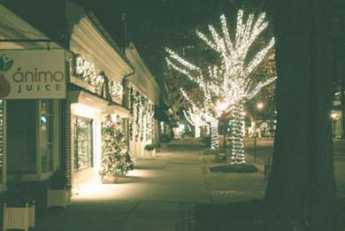
|
| Haddonfield Christmas Lights |
DECEMBER. The last of the outdoor blooms disappear at Thanksgiving. The last fall-blooming (Sasanqua) camellias, witch hazels and surviving rose bushes finish up, and the glorious maple trees have lost their fall foliage. In a warm year, the lawns remain green through Christmas, while the town lights up its trees and shrubs, and doorways, and lamp posts. The church carillon plays carols; it gets dark early. Old timers tell you of once riding to Moorestown for Christmas in a one-horse open sleigh. Winters are definitely getting warmer, but it's unclear whether this has to do with global warming or just hot water from a million drain-pipes warming up the rivers. The Philadelphia water department reports it extracts seven times as much water from the river as flows past from Torresdale to Marcus Hook. Each drop must go through seven sewage systems during that transit. Warmer weather or not, one gets to wishing the home oil delivery services would post their prices on big signs, the way gas stations do. Price controls are abhorrent, but sometimes the competitive marketplace could use a little help.

|
| Holly Berries |
JANUARY'S Ice and snow, as sung by Flanders and Swann, make the nose and fingers glow. There's not much blooming outdoors along the Atlantic coast north of Cape Hatteras in January, although the holly berries are still colorful, especially when surrounded by a thin dusting of snow. There is at least one Haddonfield family, the Coffins, who make a hobby of growing a wide variety of holly variants, many of them quite hard to grow. For some semblance of outdoor color in January, however, red berries on a tall bush show up best.
In my family, we also resort to Christmas cactus for flowers at this time of the year. It's a house plant, however, and it's a succulent, not a true cactus. In spite of the name, it only reliably blooms at Christmas if you force it to. Our formula is to stop watering it at Hallow E'en and resume watering at Thanksgiving, keeping the plant in semi-darkness during that period. Even so, it's more naturally a January bloomer, and among the easiest indoor plants to maintain. Our Christmas cactus plant is in its fourth generation within our family, with three living generations maintaining descendants of the original plant. Grandma's Christmas cactus is a living link within the family, helping us to remember who we are.
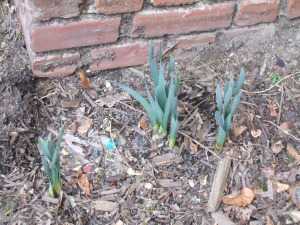
|
| Early Sprouts |
FEBRUARY'S slush and sleet, sing the Englishmen, freeze the toes right off your feet. Toward the end of the month in one of Haddonfield's milder winters, you can expect the snowdrops to flower around the base of dormant dogwood trees. These bulb plants are not very showy except for being the only thing in bloom, so plant a lot of them in clusters in the early fall, using loose soil so they can naturalize. Generally speaking, rabbits leave them alone, and in a week or so they are joined by Snowdrops, Glory of the Snow, and FSquill. The leaf fall from dogwood trees from is so dense you probably find bare ground around the base of the tree; needs something to brighten it up. The red holly berries are still on the bush; if you are lucky you have varieties of holly with white stripes on the leaves, although variegated plants are less hardy than the plain green ones. During a mild snap, daffodils poke up spikes of leaves, and a few of them have tinges of yellow. Haddonfield can get a ton of snow in February, but not every year. Some years are so mild they snatch away all the fun from neighbors who take cruises or go to southern climes for an unnatural suntan, but older residents can remember years when the Delaware River froze over. The early blooming magnolias are in bud, offering promise of what is to come. Almost everyone's lawn is a dormant brown.

|
| Snowdrops |
MARCH arrived like a lamb this year, not every year. After a late 5" snowfall melted, the snowdrops carpeted the beds under the dogwood trees. The snowdrop idea is spreading; several neighbors have clumps of them. Plant them in clusters, not strings; in loose soil, they naturalize freely. Daylight savings time arrived, making a lot of people late for church, but helping to give the feeling of spring, which isn't officially here until March 21. The daffodils are up, showing tips of yellow. Magnolias are in bud, the grass is brown, but peppered with shoots of Star of Bethlehem. The star plants are nice but thrive in muddy areas to the point they seem like weeds. As bulb plants, Star of Bethlehem come up in the spring looking like rich green early grass. Since no chemicals seem to affect them, the best you can do is mow the fresh-looking "grass" as early and as close as you can; it retards them, maybe making them die out. If you let them bloom and go to seed, you are lost. Star of Bethlehem dries up and dies on the first really warm day, leaving a bare patch in the lawn, which crabgrass is happy to fill up. March 12: Crocus, out of nowhere, blooming profusely before the daffodils make the leap. The first year you plant bulbs, they come up slowly; in years after that, they seem to jump out of the ground. Planting a few new ones every year is a way to extend the season. Sooner or later the crocus will die out; better to stick with snowdrops and squill, which will usually naturalize. By the end of March, the crocuses are fully out, the Glory of the Snow is truly glorious, the squill abundantly naturalizing in the lawn. are suddenly in full bloom because the buds are hidden under the leaves until the flowers push forward. Hellebore gets better every year, filling up shady places and somehow repellent to rodents and deer. The opposite is true of hyacinths, which get a great start but are quickly eaten by rabbits attracted by the nice odor. Forsythia are starting to blossom, sort of straggly if wild, but brilliant yellow if . Lots and lots of buds are appearing on the bushes.

|
| Forsythia |
April Fool's day really starts the main season for Haddonfield blooming. The most striking announcement that Haddonfield is ready to go comes from the magnolia trees, because they are thirty or forty feet high, completely covered with bloom. Depending on the rainfall, and whether you fertilized adequately, the lawns are now green. Most people start mowing their lawns a week or so too late, leaving the brown stubs of last year's grass showing, and allowing the confounded Star of Bethlehem to get a start. Back down at ground level, the clumps of Glory of the Snow and Squill make a very welcome show at this time of year, but the Snowdrops are pretty well over. If you are doing this sort of small-bulb edging, it's best to mix all three in the same bed to extend the small-bulb season. Flowering quince trees (or bushes, really) come out on April Fool's day, but they are easily nipped by a cold snap, and revived by warm weather. In some years when the temperature hovers around the freezing point, it is possible to have three different bloomings of flowering quince, extending over several weeks. The Hellebore stays in bloom for several weeks in April, although the foliage grows up and hides the blossoms. If you plant magic lily among the Hellebore, the leaf fronds will mix among them and then die down; the tall lily blossoms appear "like magic" in August. Daffodils are in abundance at this time, in case Wordsworth is watching, making a ground-level yellow display underneath the yellow forsythia, also in full bloom. Blooming at the same time are the mucronulatum azaleas, which are really rhodedendrons, showing a nice lavender color. Like the forsythia, the wild types are rather scrawny and sparse, while the hybrids have thickly blossomed with a brighter hue. Eat your heart out, neighbors; with these early bloomers we can have a showy spring display a month earlier, at a time when you are hungry for spring color. Notice there are four common plantings which are broad-leafed but retain their leaves all winter. Evergreens with needles, of course, but in addition the Korean dogwood is green all winter, the magnolias have shiny leaves year-round, and the scuba. Acuba are a very worthwhile addition to any garden, because they flourish in shade and sun, are simple to transplant just from sticking bare shoots in the ground, and quickly hide garbage cans, garage entrances, etc. They have a spectacular red berry hidden under the top leaves; trim them down six inches and you will see bright red berries from December to May. They aren't blossoms but are just as colorful. Some people plant crocus and hyacynths for this season, but my advice is they are just too attractive for rabbits when you can fill the same space with daffodils and Glory of the Snow. Tulips? Well, they have to be dug up every year and replanted, and then the dead blossoms have to be trimmed after they bloom; too much trouble for me. Lilacs? Well T.S. Eliot made them famous in the Waste Land but they require alkaline soil to thrive; Haddonfield soil is naturally too acid for lilacs unless you keep putting lime on them. If you come to Haddonfield and stay for years (why not?) you concentrate on things that are low-maintenance. People who move into town from Michigan are forever planting lilac, crocus, and tulips, but that's high-maintenance in Haddonfield.

|
| Azalea |
April 7: The parade of colors is beginning. Flowering fruit trees, flowering apple trees, cherries are in abundance throughout southern New Jersey. In center city Philadelphia, someone had the splendid idea of planting Ginkgo trees along the sidewalks. They look pretty much like flowering apple trees but require very little water so they become the urban favorite. When you plant flowering trees, it may take ten or more years before you see what the effect is, especially how the color fits in with the surroundings; and by then it is too late. Latecomers to the garden competition have a better chance to alternate a contrasting color. When there's nothing else in bloom, white is pretty spectacular. But when every tree is the same, it can be a little boring. For example, this is cherry blossom time in Japan, but the Japanese have so over-planted pink cherry trees for the season that although overwhelming at first, eventually the universal pinkness is pretty boring indeed. Meanwhile, all of the deciduous trees are starting to leaf out, but haven't reached the point of identifiable leaves. In many ways, this is the most beautiful brief season of the year, as every tree shows lacy tracery against the sky, but only for a few hours before the leaves appear.
April 16: The pachysandra ground cover is covered with clusters of little white flowers, which usually last for less than a week. It's hard to justify planting them for that, but important to remember an old maxim: That which grows on bare ground under a Norway maple is pachysandra -- maybe. For this purpose, Haddonfield used to have a great deal of Periwinkle, whose bright blue flowers seem somewhat more persistent because they do not all come into bloom at once. Periwinkle takes a fair amount of care, however, particularly to rake the Maple leaves away in the Fall without uprooting the ground cover, water in the summer, fertilize in the Fall; so it's falling off in popularity. If you like little blue flowers that are easier to manage, try Forget-me-nots, which come into bloom at the end of April and persist for a couple of weeks. This the magic time in South Jersey, where all the trees seem lacy with early leaf, and the laziness is echoed by Japanese cherry trees, star magnolia, and forsythia; it's a pity this wonderful moment only lasts a few days. The grass is generally green, but still growing slowly.

|
| Pink Dogwood |
MAY is heavenly in Haddonfield. Three main acid-loving plants dominate the scene: azalea, dogwood
Little blue blossoms as a ground cover are another garden feature which can give the appearance of an extended season. The glory of the Snow is planted as bulbs in the fall, coming up just as the snowdrops fade away. And then the little blue flowers of periwinkle take over as a ground cover when the forsythia is out, followed by Forget-Me-Nots during the azalea season. Grape hyacinth fit in here, too. Bulbs, ground covers, and perennials are very different sorts of plants, but the low-growing little blue flowers are much the same at a distance and can give the appearance of almost two months of continuous garden effect. Along with lily of the valley, which has a sweet fragrance, it is possible to replace the bare-earth appearance of a landscaper's commercial flowerbed with a display that is fun to watch in its subtle variations -- almost all spring long. Don't forget a patch of Woodruff, which makes a nice ground cover like pachysandra, with the bonus that a few blossoms floating in a bottle of cheap white wine convert it into delightful May Wine, Haddonfield style.
If you drive around Haddonfield in the spring, you can come across occasional homeowners who have gone too far with azaleas. They probably didn't realize what they were doing when they installed far too many azaleas of different color and habit as small plantings. But after twenty years, these bushes will grow pretty big and shaggy, looking especially overdone when one house is like this, but all the neighbors have nothing but green yards. This problem can be addressed by removing a few of the biggest bushes, and less appropriately, by trimming them like hedges. Overdone gardens like this need to be pruned, and rather severely. The best time to do it is just after the blooming has stopped, which is also the time when the recollection of kitchiness is most acute. These people mean well, so be kind to them.
May 15. The trees are almost completely leafed out, and the grass is lush green. It's easy to be fooled by the grass, which can contain a lot of annual bluegrass and clipped-off Star of Bethlehem which will die off on the first really warm day, usually in June, leaving bare spots. What you need is perennial bluegrass, preferably of several varieties to resist diseases. Matching the full leaf-out of the trees are the hybrid rhododendrons, which are essentially the same as azaleas but taller and somewhat showier. They are less hardy than other rhododendrons; sometimes six or seven of them will be killed by a sudden cold snap, ruining your garden effect; so don't depend on them exclusively. Wegelia is out now, with nice effect, too.
Memorial Day used to be the last day of May, but to create three-day weekends, it now varies in timing by several days. In some regions, it's traditional to look for peonies, all crawling with ants, on Memorial Day, but in Haddonfield, it's the time for Mountain Laurel to be in full bloom. It takes ten to fifty years to produce an effective laurel bush out of a puny little potted plant, but when you do grow one, it makes a pretty spectacular Memorial Day. Laurel is the state flower of New Jersey and Pennsylvania, but it seems less popular as a garden plant than it once was. There's also the mean rumor that honey from laurel blossoms is poisonous, but it's hard to get scientific verification of that. So many wildflowers are in bloom in late Spring, it seems relevant that the documented episodes of poisoning mostly date from the Civil War when both Northern and Southern armies were foraging in the North and South Carolina mountain wilderness. Belladonna would easily explain the symptoms the soldiers reported. There's still a Memorial Day parade in Haddonfield on Memorial Day, now much smaller than the one on the Fourth of July, although fifty years ago it was the other way around. Very likely, the Civil War veterans died off and World War I veterans favored Armistice Day. The American Legion, now mostly World War II veterans, has taken up Memorial Day, while the Veterans of Foreign Wars (originally Spanish American War, now Vietnam veterans) seem to like Independence Day. It does seem we have too many wars because it's possible to think of several others that haven't even adopted a parade.
JUNE in Haddonfield is usually a month with two seasons, late spring and early summer. At the start of the month, the left-overs from late May are still blooming, but winding down. The Mountain Laurel and hybrid rhododendrons start the month in full bloom, and then gradually fade out by about the tenth of June. Sweet magnolias come out then, with rather amazingly big flower buds. There are Easter lilies, and roses in great abundance. Astilbe in several colors is at the base of the larger bushes, and the lawns are still richly green, even bluish tinted. There are bunnies running around aimlessly, and squirrels seriously pursuing their tasks; comparatively few birds are on the ground, but up in the trees there is a great abundance of songbirds, especially early in the morning. They better watch out, a neighbor reports nesting hawks, and those owls are somewhere around.
June 15. The early June blooms are fading, but some straggler azaleas and hybrid rhododendrons persist, especially in shady areas. But the middle of June is the time for the hydrangea to pop out, and if you have taken care, there will be several interesting varieties in several colors. The Korean dogwood is just starting to blossom, about the time you gave up and assumed they never would. The blossoms (corms) start out tinted green and then turn white as they grow in size, and for some reasons, the tree will blossom in some areas well before others. This tree looks deciduous, but in Haddonfield at least the leaves remain green on the trees all winter long. And now, the wild rhododendron starts to blossom, continuing up to about the Fourth of July. These bushes are big, and they bloom abundantly, but the blossoms tend to be deep within the foliage, bloom sequentially instead of all at once, and are thus much less showy than the hybrids. But if they have been planted near the outside of a window, the blossoms are quite nice when viewed from inside the house. Sort of house plants, growing outside. Be aware of a sudden burst of hot weather. The Star of Bethlehem will suddenly grow brown, and the annual bluegrass will die as well. his is the moment in the season when a good lawn suddenly looks second-rate, but a really really good lawn just shows 'em all up. Merion bluegrass; there's nothing like it.

|
| Independence Day |
JULY'S first week revolves around the celebration of Independence Day, and in Haddonfield that means the Parade. Since the Declaration was ratified and the State of New Jersey was then immediately founded in the Indian King Tavern, the excitement is natural enough. There are fireworks and antique cars, string bands and bagpipers, service clubs and neighborhood displays, but any old-timer will tell you the central excitement of the parade and the memories generated, focus on the little kids with decorated bicycles. As far as flowers are concerned, the main display is the wild rhododendrons, with daylilies starting up, and hydrangea of many colors. There are a few Southern Magnolias, especially one in front of the Episcopal Church, with flowers as big as dinner plates, but most of these flowering trees have been planted fairly recently so the blooms are sparse. Give them a few good growing seasons before they make an impact on the town. By mid-July, most of the color is coming from window boxes and perennials along the borders of the lawns. Here's one thought about nature in the summer: Although the dominant front-yard color in Haddonfield in July and August is green (the flowering annuals and perennials are mostly in the back yards), there is the question of insects and birds. The buddleia plant attracts butterflies and hummingbirds, honeybees are attracted by the flowers of Hosta, and phlox attracts lots of bumblebees. We're in the migratory path for birds, so there are spring and fall migrants; nesting birds predominate in hot weather, so that's what should be attracted to bird feeders with sunflower seeds. It isn't unusual for a house to have eight or ten bird feeders, where the main problem is squirrels, lots and lots of squirrels. Chipmunks and squirrels are fun to watch, just like hummingbirds and bumblebees, but you should give some thought to what kind of ecosystem you hope to promote.

|
| Crape Myrtle |
AUGUST in Haddonfield features Crape Myrtle, which comes in many shades of red, and many sizes from three-foot bushes to thirty-foot trees. They are a southern flowering bush, just barely hardy this far North, so it pays to shelter them a little when you plant them. For the most part, blooming flowers in Haddonfield are mostly found in the back yards during August. The annuals are too numerous to mention, so an experienced gardener groups color schemes. Another trick is to plant seven-foot sunflowers in the back, five-foot gladioli in front of them, and three-foot phlox in front of that. Let's not forget to mention crabgrass. When the ground is wet they are relatively easy to pull up, when they get to be twelve-inch mounds they are almost impossible to pull. Newcomers are pleased crabgrass is such a quick-growing thick green turf, but they are the enemy and don't you forget it. They are an annual, so the first frost turns them brown, and they seed themselves relentlessly. Part of enjoying a garden is learning to enjoy pulling up crabgrass.

|
| sunflowers |
SEPTEMBER, remember, as the mariners say about hurricanes. Somewhere it is written that 80% of the rainfall along the Atlantic coast in the autumn is caused by coastal storms, sometimes hurricanes, sometimes nor'easters, sometimes just storms. Variability of the rainfall in autumn is one of the main causes of variability in spring gardens. Since September is the perfect time to put in new grass seed, the quality of lawns has a lot to do with coastal storms the year before. It's almost three months since the days started getting shorter on June 21, so the flowering plants are starting to fade. Crape myrtle is good for the first two weeks, and spider plant gets three or four feet tall, an annual that looks like a flowering bush. The August blooms, of sunflowers and phlox, are starting to droop a little. It's definitely time to go to the local plant store and get a dozen or so chrysanthemum plants. Yes, it's possible to debut them in the summer, prune them into tight bushes, and have a perennial that comes back every year. But you have to be a slave to chrysanthemums all spring and summer in order to have anything as full and compact as you can buy at the store. There are lots of 'mums in Haddonfield all fall, but almost all of them are purchased in pots in September.
September is the critical moment for good lawns. Permanent lawns go dormant around the end of August, and even the best of them look a little shaggy then. The most neglected lawns die at this time, for lack of water, fertilizer, excess heat, and so on. However, permanent lawns with lots of bluegrass will respond to this weather signal by thickening up, one shoot dividing into three or four, and after a week or ten days will produce the best lawn of the year. Now is the time to fertilize, now is the time to reseed bare patches; every few years it may be time to thatch and thin out, although the lawn will look terrible for a month after hatching. If you seed, mainly use bluegrass plus a little fescue for shady areas. When reading the box of seed, just ignore the ryegrass, even if it says "permanent" ryegrass. Treat ryegrass as just so much sand diluting the good grasses; only use it if you are planning a quick sale of your house and want it to look nice for a few months. The secret of a good lawn is fertilizer, but of course, you can't grow wheat if you plant corn, you must give it some good seed worth fertilizing.

|
| Fall Leaves |
OCTOBER, according to the New England college drinking songs, is when the leaves do fall, so early in October. However, those who prefer the advantages of living in Haddonfield have the additional advantage of finding that in Haddonfield, the leaves turn brilliant and start to fall, so late in October. The rest of the color in October is left-over from the September fall revival. Lots of colored leaves lead to lots of leaves on the ground to rake. And you better rake them off the lawn, too, or else they will rot and kill the grass, leading to bare ground, which washes away from the tree roots and looks just terrible. So rake, and rake cheerfully. Blessings on the Borough, which sends trucks around to suck them up into trucks and takes them away, so they don't clog up the storm sewers with disheartening floods in the streets when it rains, as it frequently does when fall hurricanes sent storms up our way. Remember, do your share of leaf raking, and do it both quickly and cheerfully.

|
| Chrysanthemum |
NOVEMBER has some late-blooming flowers, especially chrysanthemums and others of what Linnaeus called the Aster family, but which DNA studies show are just late-blooming flowers that sort of look like chrysanthemums. We're not going to get into this argument since the use of DNA typing seems to lead to placing the typical florist's chrysanthemum outside the chrysanthemum family, and endless other confusion which would serve this website no particular good until it settles down in forty or fifty years. A few stragglers like the spider plant will continue to bloom into November unless there's an early frost, along with "Asters" and dahlias, but all of that is a lot of trouble for a suburban landscape after school has begun, and the leaves are piling up, taking time to rake during short daylight hours. Be content with the glorious colors of the many maple trees, especially those lining the long straight streets like golden arches. We don't have much red color in the maples, such as you see in Vermont, so it's a good idea to plant some Euonymus bushes which will soon grow into trees and have stunning scarlet leaves in early November. The one really good fall-blooming shrub is the fall Carmelia, which comes in a variety of colors, but the white shows up best in my opinion. Camellias, whether of the fall-blooming or Japonica variety, are truly best suited to more southern climates. However, if you can find a place that is both sunny and protected -- a difficult combination to find -- they can grow to a height of six or eight feet, covered with blossoms at a time when foundation shrubbery is ordinarily pretty drab. After ten or fifteen years you can expect an early frost finally to get them, so don't be disheartened if that happens, just start over. If you have the sort of employer who transfers people every two years, just stick with pots of florists' chrysanthemums.

|
| The glory of the Snow |

|
| Spring Budding |

|
| Spring Budding |

|
| Daffodils |

|
| Crocus |

|
| Japanese Cherry |

|
| Grape Hyacinth |

|
| Narcissus |

|
| Azalea |

|
| Wisteria |

|
| Lily of Valley |

|
| Magnolia |

|
| Money Bush |

|
| Forget Me Nots |

|
| Tezou |
Geckos: Academy of Natural Sciences brings Mini Dinosaurs

|
| Gecko |
FRIENDS who spent time in Vietnam have a lasting memory of lizards stuck to the ceiling, catching flies with their tongues. Those animals are named geckos, one of the oldest and probably most varied families of reptiles, but confined to the Southern hemisphere. Fossils have been found containing geckos from fifty million years ago, so they were here before the big dinosaurs were wiped out, when the Yucatan was probably struck by an asteroid.

|
| Anthony Geneva |
There was a time when Africa, India, South America and Antarctica were united in one monstrously big continent, and the many varieties of gecko are scattered over the land masses which originally made that up. At least this is the way Anthony Geneva explains it to visitors to the Academy of Natural Sciences at 19th and Ben Franklin Parkway. There are no geckos to be found naturally in Philadelphia. Philadelphians hardly need reminding that the first dinosaur bones, ever, were discovered in Haddonfield NJ, and were soon taken to the Academy for permanent display. Ever since that time, the Academy's collection of dinosaurs has expanded, and are the things with the most impact on school-age visitors. The Academy is getting ready to celebrate its 200th anniversary in a few years, however, and contains much more than dinosaur bones, including extensive research facilities with world-famous scientists at work in them. In any event, the dinosaur image is a clear metaphor for the present display of little reptiles that look like dinosaurs, whatever the DNA trail may be. The main exhibition area is currently filled with dozens of glass display cases containing live geckos, and the little rascals are so good at camouflage that you have to hunt carefully for them before they suddenly seem to emerge from the shadows. There are white ones, black ones, bright green and bright orange ones, speckled in all sorts of weird patterns. They make sounds resembling bird songs, and the term gecko is a native word referring to such sounds. The Academy displays these gecko-noises for visitors who are invited to push twenty or so buttons. Geckos move, but suddenly, and probably for some predatory purpose. If you are really into geckos, you focus on their feet.

|
| Gecko |
The variety of toe and foot shape is almost infinite and seems more so if you have a magnifying lens. The foot pads terminate in different kinds of extremely fine hairs, and that's their big secret. Those hairs are so fine the molecules of the foot and the molecules of the wall or ceiling attract each other magnetically. Since no energy is expended in the adherence, the gecko can remain attached to a wall or ceiling indefinitely, even after the gecko dies. But, by raising the angle of contact to thirty degrees, the foot detaches, and the little rascals can scoot along very rapidly, upside down. At present, there is a great deal of commercial and maybe military interest in clarifying the secrets of this adhesion. To be industrially useful, the footpad size would have to scale up to much larger dimensions, but just imagine gluing together the vessel ruptures and aneurysms inside the brain as we now do in a cumbersome manner with chicken-wire stents, just one example that quickly occurs to a visitor. If these little fellows figured out how to make these reversible adhesives fifty million years ago, our scientists ought to be able to imitate them.
Drop around to visit the Academy. It's filled with amazing things like this.
What To Do If You Have a Heart Attack

|
| No Ambulance, But Faster |
On a pleasant Spring Sunday some time ago, I was at home, doing nothing in particular, when I suddenly experienced severe, crushing pain deep inside my chest. No doubt in my mind what that meant, so I quickly took an aspirin and looked at the clock: 6:50 PM, daylight time. Out the window to my right, my neighbors were having a yard party, so I walked thirty feet over to them. Side-stepping the big Hollywood hello, I told my neighbor I was having a heart attack and would please like a fast trip to the hospital. There was some talk of calling an ambulance, but that was brushed aside. No time.
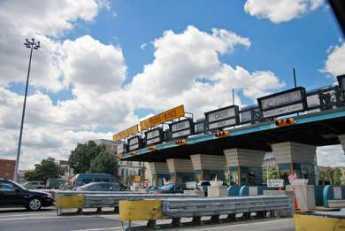
|
| E-Z Pass Speeds the Trip |
Neighbor Charlie took the wheel, a friend got in the back seat, and off we went, fast. About that time, I started to sweat, just like they say in books, but to my surprise only after two or three minutes of the pain. The pain continued unchanged. Luckily, on Sunday evening, traffic was light. Down the main road to Benjamin Franklin Bridge, through the gate with E-Z Pass, over the bridge, turn left. I asked the man in the back to call the Emergency Room on his cell phone to tell them I was coming in, please get the cardiac intervention team to come to meet me at the hospital in a few minutes. We made one wrong turn on a one-way street, adding three blocks to the ride. I knew better but didn't feel equal to protesting. We were soon at the right door, and then into the reception area of the Emergency Department. This area is almost brand new; the first time I had been there. But I had been all over that hospital every day for years at a time, and for two years had been the Physician in charge of the Emergency Room, myself.

|
| Electrocardiogram |
I didn't recognize the nice lady at the desk, who wanted to know my next of kin, Medicare number, other insurance coverage, the color of my eyes, the name of my dog. My companions are very large fellows, and I was about to tell them to be polite, but if necessary knock her down, when actually I said the magic words,"Severe chest pain". That was part of her standard protocol, apparently, since I was immediately ushered onto a stretcher through a side door, had an electrocardiogram, watched the resident pick up the phone to call the cardiac team. Then I waved off somebody's informed consent speech to the effect that I didn't just consent to, but in fact, demanded an angioplasty. My clothes were taken away, intravenous lines were placed, ice-cold antiseptics were swabbed around. I was shaved in a business-like way in what the lady cutely called a Mohawk. The surgeon appeared, started his own informed consent speech which was waved off. The locks on the wheels were kicked loose, the stretcher started for the elevator, surrounded by scrambling attendants holding bottles. When we came to rest under a big light in some ceiling, I looked at the large wall clock. It was 7:20 PM. That was exactly thirty minutes after the pain began.

|
| Cardiac Catheter |
I was more or less awake during the whole procedure, getting to watch the dark black line of the catheter moving around on the scope beside me. I didn't know this particular surgeon, but it was obvious he was good. Usually, you can watch the catheter tip advance, then pull back, try again, pull back, try again and hit an obstacle. This evening I had the joy of watching a virtuoso performance, with the catheter smoothly advancing to its destination, twist and come to rest. Black dye squirted out, outlining the artery and its branches. The electrocardiogram correctly predicted the obstruction in the right anterior descending artery, and to general relief, the other atrerieswere "clean".
Probably because I got there so fast, plus swallowing an aspirin at home and chewing several in the Emergency Room, no clot had formed around the obstruction, which apparently was caused by a plaque of cholesterol with a split in it occluding the wall of the artery by bulging into the lumen. There seemed to be no clot behind the plaque or in front of it. The catheter had a stent over the balloon tip, which is to say it contained what amounted to braided chicken wire. The whole contraption gets opened up by inflating the balloon, then deflating and withdrawing it, which allows the artery to be held open by the unfolded chicken wire which remains in place. With the early versions of stents, fibrous scar tissue would grow over the chicken wire and block up the artery a few weeks later. Hence, the stent was coated with a chemical which prevents fibrosis. Unfortunately, this chemical also retards the growth of cells which line an artery on the inside, so coated chicken wire provokes clots. While I was still in the operating room, the solemn incantation was begun: I must take an anti-clotting drug every single day for a whole year, and if I missed a single pill, I could immediately die. I was to hear this incantation twenty times, so I guess they really mean it.

|
| On a scale from 1-10, how bad is it? |
Well, I was asked to call out a number from one to ten, indicating severity of chest pain. It had been "three" when I got to the operating room, even though it had begun as a "seven", and rose to "seven" several times during the procedure. Seven was my own invention; if I had to ask for pain-killer it was going to be an eight and would get to nine if I had to cry out. It never got worse than seven. When they pulled the catheter out of my groin, it was zero. It has stayed zero ever since.
It was a cause of some interest that my enzymes never rose. When heart muscle is injured, characteristic enzymes leak out and appear in blood tests; you can more or less measure the extent of the damage by the level it reaches. I had reached the emergency room so quickly the enzymes had not had a chance to rise. And the artery was re-opened so soon, they never did rise. For the first time in my life, my blood pressure was 250, so I guess I wasn't as calm as I let on. Somewhere during the procedure, the sweating stopped.

|
| Severe chest pain |
So, off to the cardiac care ward, where the custom is for each attendant to write his or her name on a whiteboard, while the date and time are prominently displayed for continuing orientation. They give you a phone so you can call your nurse, but my suggestion is to offer earplugs to drown out the continuous chatter at the desk. A patient of mine once called it the Racket Club. The food is, well, hospital food. Protocol says it should have no salt. I discovered that breakfast arrives on the dot at 9 AM, supper on the dot at 5 PM, lunch somewhere in between. I believe I understand the reasoning. Two days of this, and I'm discharged. Nothing to it, if you get there fast. Let me repeat, if you get there fast.
Since this light-hearted day trip is in sharp contrast with the six weeks of strict bed rest so routine in the days of my internship, not to mention the considerable mortality and disability that prevailed until quite recently, it justifies some reflection. As a medical student, I knew Andre Cournand and Dickenson Richards, who perfected the cardiac catheter. They were awarded Nobel Prizes, as was Michael Brown, who invented the statin drugs to lower cholesterol. Affable and modest men, they have saved millions of lives, now including mine. Or at least they did so, with the assistance of thousands of other doctors who perfected one by one the details of the little minute we danced in the operating room, each adding some little refinement, or eliminating some little hindrance to success. But, doggone it, you have got to get to the hospital fast.

|
| Helicopter Dreams |
To do that, you have to give it some thought in advance; some community organization would also be useful. In my case, waiting for an ambulance would have slowed me down. Not everybody can live within a few minutes fast drive of a hospital, and not all hospitals are equipped to handle such cases. The range of effective rescue could be extended with helicopters, but you have to give some thought to where you would have to drive to find a place for a helicopter to land. Philadelphia is almost unique in having the largest evacuation company in the world, headquartered in Trevose, but it would take a lot of negotiation to arrange a system for the whole Philadelphia area. It just happens my oldest son was helicoptered off a mountain in Nepal this year (by an affiliate of this company), but his helicopter almost ran out of gas. These things can be done, and yearly evacuation insurance is about $200 a year, anywhere in the world. But it would take an awful lot of community planning and argue -- and maybe suing -- to make it happen. Is it worth it? Sure, but a little hard thought in advance might offer better solutions for most people.
Plays and Players, Haddonfield Version
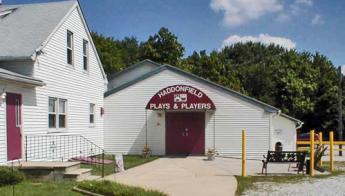
|
| Haddonfield Plays and Players |
First, an anecdote from my own lurid past. When I went there, Yale was an all-male institution with one exception, the Drama School. It's true that Shakspere had boys play the part of women in his plays, but Yale evidently felt that was going unnecessarily far, and had thus let the nose of the female camel get under the all-male tent. Meanwhile, I had discovered that a course in Advanced Chemical Engineering was carrying my amateur interest in chemistry sets a long way too far, and after two weeks, I wanted out of it. Out!
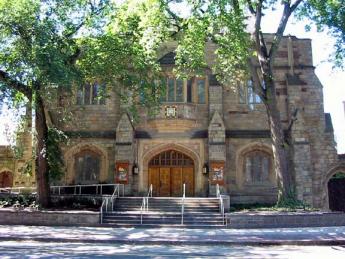
|
| Yale Drama School |
The Dean was sympathetic until I answered what I wanted to transfer into -- a course at the Drama School. Somehow, he felt that was immensely amusing, one he hadn't heard before. But, finding my grade average satisfactory, he gave a big wink and signed the paper. I didn't pretend to be offended, but I did pretend to be solemn. The experience subsequently served me very well, since that class of girls went down to Broadway at the same time I went down to New York to medical school. Almost none of my mostly all-male class of medical students knew any girls in New York, but by comparison, I knew lots. It made me very popular with both groups.
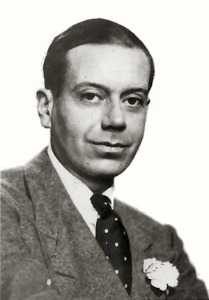
|
| Cole Porter |
It thus develops that I had the courage recently to accompany to a theater party in Haddonfield, a lady who had spent twenty-five years on the stage. The play was Cole Porter's Anything Goes, put on by the Haddonfield Plays and Players, a group celebrating its 75th year of productions. You seldom see musical comedies anymore, because the large cast and orchestra requirements are pushed by Union rules to the huge expense which a professional group cannot safely risk, and amateur groups mostly cannot enlist a large enough audience to support. In addition to the orchestra, stagehands, and administration, I counted thirty members of the cast up on the stage for the big chorus numbers. There might have been a hundred in the audience to pay the bills. This wasn't the only play of the season, there will be five I understand, so the performers have to be quick studies, which generally means considerable experience. Even with what therefore must have been a short time to rehearse, this group was good, really, really good. The lady by my side remarked these people must be semi-professionals, at least. I didn't think so, so she demanded a playbill to see. Sure enough, semi-pro.
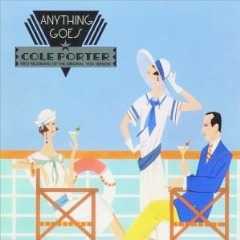
|
| Anything Goes |
All of which may seem a round-about way to get to an observation about the current theater revival in Philadelphia. There are at least fifty new amateur theater groups scattered throughout our region, filled with "kids" having a wonderful time playing Shakspere, Albee, Shaw and whatever. At cast parties, almost none of them expresses any interest in going to Broadway or Hollywood; they are mostly software engineers or similar. Since the Philadelphia revival of interest in performing arts is so striking, it has led to ruminations about why the theater similarly flowered in Elizabethan London, at a time when there were only two theaters in Paris, by comparison. Perhaps this parallel has something to teach us about the hidden social impact of Sir Thomas Gresham and dual coinage, or Sir Francis Drake and the Armada.
But maybe, I realize for the first time, there is a flight in our direction, from New York City.
The King's Road
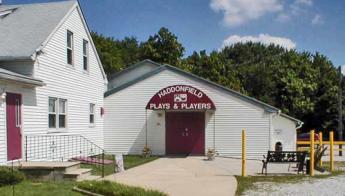
|
| Plays and Players of Haddonfield |
Harry Kaufman may not have started the Plays and Players of Haddonfield, but he certainly sparked it to a near-professional level in a town of 7000 people. The orchestra and the ballet company are particularly outstanding at the moment, the soloists on the stage quite good, although they never made the grand European tour which is thought to be the prerequisite for getting into the big time. Harry was the life of any party, and particularly good at composing little ditties, never quite getting around to stringing them together into a musical comedy until the 250th anniversary of the town. Even then, it is recalled he was shy and reluctant and had to be pushed a little. Since The King's Road appeared shortly after Oklahoma! transformed, even revolutionized, American musical comedy, it was not only the model but the stimulus for a similar comedy celebrating the beginnings of our little state. The plot was a simple one of a conflicted love affair. The striking innovation of Oklahoma! was to crowd most of the show's songs into the first act, repeating snatches of their themes as sort of Wagnerian background commentary throughout the remainder of the play. The other innovation of what was originally called Green Grow the Lilacs was the addition of Agnes DeMille's ballet company to emphasize the real historical theme with light-hearted music. Since I was one of the original reviewers for Oklahoma! in its New Haven tryouts, I can remember the revolutionary impact of that play, very well.

|
| Anthony Wayne |
Harry had to go to the Historical Society for authentic details of the conflict between the attraction for Revolutionary aspirations for Liberty, and loyalty to the earlier sufferings of Quakers for their pacifist leanings. Some Quakers deserted their faith to join the Revolution, and other Quakers tried to convert the Hessian soldiers. And still, others were loyal to the King of England. The Revolution was almost won at this moment, as the British occupants of Philadelphia had abandoned their supplies to attack, and had to get to the British fleet, bottled up in the lower Delaware River by fortifications at Fort Mifflin and Fort Mercer on the Jersey side of the river. The Hessians had been sent to attack Fort Mercer from the rear, passing through Haddonfield and stopping one night before going on to what we now call National Park. While the Hessian officers were being entertained by John Gill with discussions of the futility of war, Jonas Cattell slipped out of town and ran to alert Fort Mercer of its danger. The guns of the Fort were turned around, and the defenders pretended not to notice the approach of the Hessians until they were ambushed and largely destroyed. If Fort Mifflin on the Pennsylvania side of the Delaware River could have held out, the starving British might have had to surrender, but that didn't happen. In any event, the New Jersey Militia did its part, and little Quaker Haddonfield helped them in a sort of characteristic Quaker way. With a ratta-tat-tat and a fiddly dee, the rag-tag swallow-tail Jersey Militia got all the credit.
The play does not emphasize that the State of New Jersey was founded at the Indian King Tavern during these commotions, or that General Washington starving at Valley Forge sent Mad Anthony Wayne to circle up and around Trenton to drive a herd of cattle back from Salem County, two hundred miles back to Valley Forge. The British sent Captain Simcoe down to Salem County to massacre the Quaker farmers who provided the cattle. These later developments are only mentioned in its anthem to "Generals Wayne, LaFayette, and Pulaski", and every good resident of Southern New Jersey is supposed to know what that is all about.
The Quaker historian Rufus Jones established the enduring tradition that this split is what ultimately reduced the Quakers from the dominant religious group to a small religious sect in the three states once owned by William Penn, Delaware, Pennsylvania, and New Jersey. Related to such turmoil was the claim that more battles of the Revolution were fought in New Jersey than in any other state; if you include the large privateer navy going to see from the Jersey Pine Barrens, that is probably true. And every twenty-five years or so, we have to put on a revival of "The King's Road", and just show 'em.
It Ain't Necessarily So
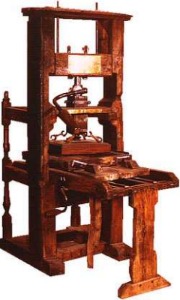
|
| Benjamin Franklin Print Press |
The Protestant Reformation provoked a wide variety of reasonings, and the Quaker position is at one extreme of them. One way of looking at it is to see the Reformation as largely a reaction to the invention of the printing press. At first, there was the impact of Latin versions of the Bible, or Vulgate, which could be read by priests like Martin Luther, and possibly interpreted by them to vary from established Church doctrine. Translation of the Bible into common languages subsequently permitted educated parishioners to read the Bible for themselves and draw their own conclusions. Fundamentalist branches of the church tend to place almost total reliance on what they can read for themselves, and consequently, authenticity is highly important to them. The Quakers go a step further, encouraging each member to come to his own spiritual viewpoint ("There is that of God in every man."), using the Bible as merely one important resource. Although others sometimes regard them as spiritually adrift, the Quaker idea is that if something is really true, everybody who thinks hard about it will eventually come around to much the same conclusion. (Related to this attitude is a strong belief in the ultimate triumph of democracy, and the essential rightness of market-set prices.) Some people try harder than others, of course, and they come to be regarded as "weighty" Friends, likely to have reached the correct conclusion somewhat sooner than others.
One very weighty Friend was Henry Cadbury, an American relative of English candy makers. Henry decided he wanted to spend his life teaching the Bible and went to Harvard Divinity School. He became in time the leading authority in the world on the Book of Acts, editing that section of the Interpreter's Bible, and rising to be Professor of Divinity at Harvard. Henry knew his stuff, so to speak.

|
| Henry Cadbury |
One fine summer day, Henry was seated in the front row of the Haddonfield Meeting. Birds twittered outside the open doors and windows, but otherwise, the gathered meeting was entirely silent. It was even beginning to look as though this meeting would be one of those occasional instances when nothing is said for an entire hour -- a "silent meeting". But, no, a visitor came through the open back door of the meetinghouse, in response to the sign found outside almost every meetinghouse, "All Are Welcome". The man was evidently a fundamentalist, and seeing a large audience all sitting silently waiting for something, he advanced boldly to the front of the meeting and began to speak.
The Bible was the Word of God. Every word in The Bible was true -- literally, and incontestably true. The theme was repeated several times, without an apparent response from the audience.
Finally, Henry Cadbury stirred himself. "Well, it has always struck me...". Oh, oh. Look out, here it comes.
"It has always seemed to me, that the most quotable parts of the Bible, are mainly based on the faulty translation."
Quaker Carillon
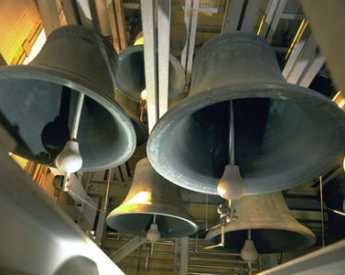
|
| Carillon Bells |
A carillon is a graded series of bells in a belfry, to play tunes. Quakers avoid bells and belfreys, but instinctively grasp the concept of a carillon. Why is that so?
Spoken messages at an unprogrammed meeting, like ringtones of a carillon, are followed by persisting vibrations of varying intensity. Care must be taken, no matter how pure the next message may be, to preserve harmony with the ring decay of the tone it has just followed. Not too soon, not too unrelated.
Overly long delays between messages may be discordant, breaking up the tune unless the message is harmonious. Lacking a tune, the messages fall apart. A silence of even longer length may restore the tune for a gathered meeting, or the next speaker may gently rebuke the interrupter. Sometimes the difference is distinguishable only when you know the personalities. A meeting without a tune is a disappointment, pointing toward individual experience instead of group unity. But death or other catastrophes can have its message destroyed by trite commentary. Rising above triteness can be one way a "weighty" meeting rises above its rank to demonstrate the fearlessness of leadership; failing to rise to an occasion is a way of demonstrating ordinariness.
George Willoughby, 95, Peace Activist
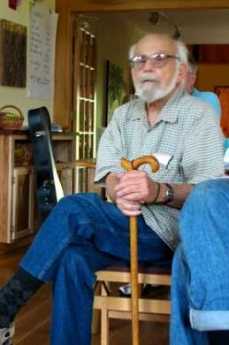
|
| George Willoughby |
Age was nothing but a number for 95-year-old peace activist George Willoughby of Deptford. His worldwide antiwar protests and nonviolent teachings started when he was in his mid-40s and continued until just weeks ago.
Mr. Willoughby was planning a six-week trip this month to India to meet friends he had made during visits to the birthplace of his idol, Mohandas K. Gandhi, and probably to give some of his trademark peace talks.
But Mr. Willoughby died at home of heart failure Jan. 5, a month short of the journey.
A Quaker who led local protests and famous treks from San Francisco to Moscow and from New Delhi to Beijing, Mr. Willoughby recruited many advocates for nonviolent conflict resolution, said a friend and member of the Central Philadelphia Meeting, Nicole Hackel.
"Once you experienced him, you didn't forget him," Hackel said, adding that she became a Quaker in the 1970s because of Mr. Willoughby's influence. "George would engage in conversation with anyone, even a 5-year-old who was attending a meeting for the first time."
Mr. Willoughby became a household name for area Quakers after he became director of the Central Committee of Conscientious Objectors in Philadelphia in 1954. He soon was a frequent presence in the news, mostly under headlines with the words peace, marchers, and protest.
In 1958, Mr. Willoughby was one of five crewmen on the sailboat Golden Rule who received 60-day jail sentences in Honolulu for trying to sail to the area of the Pacific Ocean where the U.S. government was testing nuclear bombs in the atmosphere.
That was Mr. Willoughby's first of many incarcerations, said his son, Alan.
"The Society of Friends in Honolulu brought him a lot of decent food. . . . He always spoke highly" of the Hawaii jail experience, his son said with a slight laugh.
Two years later, Mr. Willoughby organized a dual-continent march to protest nuclear testing. Protesters in groups of about a dozen each covered six countries in 10 months between the United States and the Soviet Union.
Mr. Willoughby joined the group in Poland. Soviet officials stopped them 100 yards short of the Lenin-Stalin tomb in Moscow's main square, according to reports at the time. Instead of delivering speeches, the group was forced to stand in the square in a silent vigil.
In 1963, Mr. Willoughby embarked with about a dozen others on what he intended to be his longest hike - 4,000 miles from New Delhi to Beijing to promote peace between India and China.
Before his journey, a Philadelphia Evening Bulletin reporter asked whether there was a better way than marching to bring about peace.
Mr. Willoughby responded: "Most people of these countries walk; we can reach them. Even if it does no good at all, it is worth it. It's an idea I believe in, and if it produces fruit, so much the better."
After eight months of walking, Mr. Willoughby and company were stopped at the India-China border and barred from crossing into China.
In the next three decades, Mr. Willoughby's projects included the formation of A Quaker Action Group, which opposed the Vietnam War, in 1966; the Life Center Community in West Philadelphia, a training and campaign center for nonviolence, in 1971; and Peace Brigades International, a human-rights group, in 1981.
One of his most memorable contributions to South Jersey, family and friends said, was the creation of the Old Pine Farm Natural Lands Trust, 45 acres of natural conservancy in Deptford.
In his later years, Mr. Willoughby received honors around the world for his peace work, such as the Jamnalal Bajaj Foundation award in 2002 in Mumbai, India, which recognizes those who promote Gandhi's ideas and values.
Born in Cheyenne, Wyo., Mr. Willoughby spent much of his childhood in the Panama Canal Zone, where his father worked in construction.
Mr. Willoughby was part of his high school's JROTC program, but, according to friend and biographer Gregory Barnes, he quickly realized the military was not for him.
A family rift led Mr. Willoughby to live in Des Moines, Iowa, with a family friend, Elinor Robson. In the 1930s, he received three degrees in political science, including a doctorate from the University of Iowa.
In 1940, Mr. Willoughby married Lillian Pemberton, a "birthright Quaker" he met in college. By 1944, he became a Quaker, fully immersed in the Religious Society of Friends' beliefs and ideologies.
In the late 1940s and early 1950s, Mr. Willoughby worked for the Des Moines office of the American Friends Service Committee before moving to Philadelphia with his wife and their four children.
After bypass surgery in 2000, Mr. Willoughby had to slow down. He wasn't able to participate in as many marches and rallies as he would have liked, his son said, but he remained active online.
One of Mr. Willoughby's last protests was in March 2003, an organized obstruction of the entrance of a federal building in Philadelphia to protest the war in Iraq. He took photos of his 89-year-old wife getting her head shaved as part of the demonstration.
"I've never seen her like that, but I like it," he told a reporter. Lillian Willoughby died last year.
One of Mr. Willoughby's last speeches was at Scattergood Friends School in Iowa a few months after his wife's death. He took a road trip with Hackel and one of his daughters to the Scattergood refuge camp's 70th-anniversary reunion, which was held at the school.
Once there, Mr. Willoughby did what he did best: talk. "He just fascinated the young people there," Hackel said.
Some of Mr. Willoughby's last words of advice were: "It is the duty of the opposition to oppose," his son said. "He thought it is your duty to speak up . . . for what you believe is right."
In addition to his son, Mr. Willoughby is survived by daughters Sally, Anita, and Sharon and three grandchildren.
A memorial service will be held at 2 p.m. Saturday at the Friends Center at 15th and Cherry Street
Inazo Nitobe, Quaker Samurai

|
| Inazo Nitobe |
The story of Inazo Nitobe (1862-1933) comes in two forms, one from the Philadelphia Quaker community, and the other from his home, in Japan. One day in Philadelphia, a well-known ninety-year-old Quaker gentleman, rumpled black suit, very soft voice -- and all -- happened to remark that his Aunt had married a Samurai. A real one? Topknot, kimono, long curved sword, and all? Yup. Uh-huh.
That would have been Inazo Nitobe, who met and married Moriko, nee Elizabeth Elkinton, while in college in Philadelphia. He became a Quaker, and when the couple returned to Japan, the Emperor then found himself confronted with a warrior nobleman who was a pacifist. You can next perceive the hand of his Quaker wife in the deferential diplomatic suggestion that there were vacancies for Japan at the League of Nations and the Peace Palace in the Hague. Perhaps, well perhaps, there could be service to his Emperor as well as his new religion in such an appointment for her new husband. Good thinking, let it be done. As far as Philadelphia is concerned, Ambassador Nitobe next appeared when Japan was invading Manchuria. The Emperor had sent Nitobe on a tour of America to explain things. At the meetinghouse then on Twelfth Street, Nitobe adopted the line that Japan was only bringing peace and order to a chaotic barbarian situation, actually saving many lives and restoring quiet. After a minute of silence, Rufus Jones rose from his seat on the "facing bench": He was having none of it. And that was that for Nitobe in Philadelphia.
The other side of this story quickly appears if you go to Japan and ask some acquaintances if they happen to have heard the name Inazo Nitobe. That turns out to be equivalent to asking some random American if he has ever heard of Abraham Lincoln. To begin with, Nitobe's picture appears on the 5000 Yen ($50) bills in everybody's pocket. He was the founder of the University of Tokyo, admission to which now is an automatic ticket to Japanese success. He wrote a number of books that are now required reading for any educated Japanese. A number of museums, hospitals, and gardens are named after him; one of them outside Vancouver, at the University of British Columbia.
Nitobe's father, Jujiro Nitobe, had been the best friend of the last Shogun, deposed by the return of the Emperor to effective control after Perry opened up Japan to Western ideas. The Shogun was beheaded, of course, and the tradition was that the victim could ask his best friend to do the job because he would do it swiftly. Jujiro was unable to bring himself to the task, refused, and his family was accordingly reduced to poverty. Subsequently, the Samurai were disbanded by the newly empowered Emperor, given a pension, and told to look for peaceful work. Inazo Nitobe was in law school when the Emperor's emissary came and said that Japan did not need culture, it had plenty of culture. The law students would please go to engineering school, where they could help Japan westernize.
Nitobe later wrote a perfectly charming memoir, called Reminiscences of Childhood in the Early days of Modern Japan , which dramatizes in just a few pages just how wide the cultural gap was. For example, Nitobe's father brought home a spoon one day, and this curious memento of how Westerners eat was placed in a position of high honor. One day, a neighbor ordered a suit of western clothes, and hobbled around it, saying he did not understand how Westerners are able to walk in such clothes. He had the pants on backward.
One of Nitobe's greatest achievements was to struggle with his appointment as Governor of Formosa (Taiwan). Japan acquired this primitive island in 1895, and Nitobe got the uncomfortable role of colonist in Japan's first experience with colonization. He sincerely believed it was possible for Japan to bring the benefits of Westernization to another Asian backwater, but just as the British found in their colonies, there was precious little gratitude for it. Although he was undoubtedly acting dutifully on the Emperor's orders when he later came to Twelfth Street Meeting, he surely knew -- perhaps even better than Rufus Jones -- that there was something to be said on both sides, no matter how conflicted you had to be if you were in a position of responsibility. This most revered man in his whole nation almost surely saw he had been a complete failure in Philadelphia.
School Tax Seldom Equates to School Spending
 |
| Little Red Schoolhouse |
As this blog went to press, voters throughout South Jersey had just gone to the polls to vote for school boards and school budgets. Or, at least they had the opportunity to do so, but mostly 15% of eligible voters actually troubled to vote. Meanwhile, school officials chewed their nails in apprehension that many budgets would be disapproved by the taxpayers, and then what? As it turned out, Haddonfield and Moorestown approved their budgets, but over half of the 700 school districts of the state did not. The voters wanted to send a message they were angry about property taxes, and the seemingly related fact that over half of school employees are not teachers. Some of them mistakenly believe county taxes have something to do with schools. If they had really understood the situation, they would have been angry that the size of their local school budget has comparatively little to do with the level of their total tax burden.
Meanwhile, voters with children had been agitating to support the budget or even raise it, even if it raised their taxes; but empty nesters were urging each other to go vote down this budget because their taxes were already excessive. The parents of schoolchildren urged the empty nesters to move somewhere else where they couldn't vote down school budgets. Actually, however, if more empty nesters moved in, property taxes would go down without affecting the school budget, because empty-nesters pay taxes without using the schools. Both groups are quite misguided, however, because raising or lowering school budgets would probably have very little effect on overall taxes. Even school officials failed to make their best case to the public because they misunderstood the tricky way taxes are arranged. They defend every budget by saying it is already cut to the bone. Since it presently makes relatively little difference to overall taxes whether the budget is cut or increased, that's not useful in persuading empty nesters. Budget cutting does make a lot of difference to the quality of education, however, but that's only half of the facts, not a balanced one. The moral of all this is that the voters better get educated about the Jersey political scene, before their children lose the chance to get educated at all.
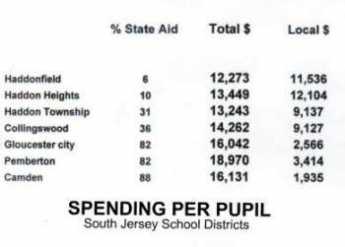
Since I'm an empty nester, I am pretty familiar with the empty-nest viewpoint. Three of my friends have told me they moved to neighboring suburbs in order to lower their tax burden; they undoubtedly know what they are talking about. But no one I know is able to reconcile that fact with the equally certain fact that Haddonfield has the lowest spending on education, per pupil, in the southern half of the state. In fact, they don't care, because they know that local school taxes are significantly lower almost everywhere else, and they don't have to explain why. School officials should be more concerned with explaining their rank in per-pupil spending compared with other districts, but they are driven to make cuts in service where ever they can in order to produce a leaner budget for the voters. They too, seem oblivious to the fact that voter anger won't be soothed for long by their budget cutting because it won't affect overall taxes. Taxes are what people are mad about, but they must consider all of them, and understand that as one goes down, the other will probably go up. In another article, we discuss how they mysteriously go up even more. A more sophisticated view would be that in addition to concern about eradicating poverty in the long run, residents of New Jersey are increasingly driven by the need to get their children into better quality colleges. They would like to improve secondary education to do so but are hampered by the relative unavailability of high-quality colleges in the state. Some of this has to do with the recent tendency of Princeton and Rutgers to seek a geographical diversity of students. But to be cynical about it, the development officers of those colleges know that major donors are to be found in Texas and California. In New Jersey, the majority of income taxes are paid by 1% of the population, and that !% are fleeing the state to avoid its heavy income and estate taxes, just as fast as they can. This is the group that tends to donate most heavily to college improvements, and New Jersey colleges are suffering from their flight. That argument may well be hard to sell in Newark and Camden, but it has a major indirect effect on business creation and employment in the state as a whole.
To return to basics, New Jersey school spending is governed by the Abbott decision, which happens to have been written by a friend of mine, who is a fine, smart, well-intentioned jurist. So-called Abbott districts were found by the courts to have significantly underfunded schools, to the point where it seemed an important public issue that the wealthier parts of the state must help these underprivileged kids get an adequate education. Whether improving the school system in their districts would reduce the crime rate, or welfare rate, among these children in later life, was not then known, but subsequent experience does not give it much support. Mainly, it wasn't so much trying to reduce public expenditures in the long run that was behind the Abbott decision, as the feeling it was the duty of a prosperous society to give deprived kids an even break, a sort of penance for success. Accordingly, state school tax revenues were rearranged in an effort to make the per-pupil spending for education approximately equal in all districts, and particularly in the most deprived areas, the Abbott Districts. The first clear sign that something unintended was happening is shown in the accompanying table, indicating that spending in the Abbott districts was in fact now about fifty percent greater than in prosperous nearby suburbs. Equality might be all right, but fifty percent greater was probably not acceptable to the taxpaying public. Just how that paradox gets accomplished in Trenton is not yet clear, but the discomfort level about it is heightened by noticing there is generally an inverse relationship between the spending per-pupil and the perceived quality of the educational product. You might compare drop-out rates, crime rates, SAT scores or whatever, but public perception is not likely to overcome data seeming to show that the more you spend, the worse the education. One wag commented that the data also seems to show that the further you get from the Delaware River, the lower the educational spending gets; that relationship is also more or less linear. So, what matters here is opinion, and the prevailing opinion is emphatic that this data is upside down. The Abbott decision that school spending must be equalized but is actually greater accounts for much of this funny data, but in addition there almost has to be some overlooked secondary factor which exaggerates the Abbott effect by as much as 50% beyond equality.
Even the education industry has an incentive to explain at least and possibly to correct, this disparity. Because in politics while you can prove almost anything with statistics, it is quite seductive to imply that this data proves that extra educational spending hurts the quality of education, at least above a certain level. The education industry wouldn't be wise to let that sort of accusation go unanswered, even if it comes as a wisecrack. The real empty-nester accusation, sorry to say, is that "My school taxes are way too high. They not only do me no personal good but are not helping underprivileged children, either." The consequence is empty-nesters are driven out of town and out of state, making taxes higher for everyone else. It could take decades to undo this damage with an angered public, so everybody better get to work explaining and correcting the problem.
How Does New Jersey State Aid Affect School Districts?
The Sunday, April 11, 2010 Philadelphia Inquirer contained an eighteen-page statistical summary of the schools within the eight-county area around Philadelphia. The New Jersey school districts, but not the Pennsylvania ones, report per-pupil spending right next to the proportion contributed by a state government. If you know something about the sociology of New Jersey, you form some conclusions about state school aid which probably apply to all states, while confessing they only provably apply to New Jersey. Let's therefore say, it only provably applies to New Jersey that you spend more on schools if you are spending someone else's money.
In the welter of numbers supplied by this statistical report, it seems useful to focus on the strip of school districts along Haddon Avenue, starting from the place where the retreating British soldiers once ferried from Philadelphia to Camden (in 1778, of course.) Haddon Avenue extends directly East until it strikes King's Highway, where the British then turned North to scuttle toward the safety of their navy at New Brunswick. We are thus talking about the school districts of Camden, Collingswood, Haddon Township, Haddonfield and Cherry Hill, with Haddon Heights and Pemberton thrown in because of special features they illustrate.

|
Pemberton Township in Burlington County spends the largest amount of per-pupil school money in South Jersey, $18,970. It jumps right out at you that 82% of that money is contributed to the school district by the state government. Starting back at the Delaware River, 99% nonwhite Camden gets 88% of its school money from the state and has the second-highest spending of $16,131 per pupil. Moving along the path of the British soldiers, the next town after Camden on Haddon Avenue in Collingswood, spending $14,262. Next comes Haddon Township, spending $13,243. It thus seems to prove that the further you get from the Delaware River, the less you spend on education, because next in order comes Haddonfield, with spending of $12,273. But not quite, because Cherry Hill increases a little to $12, 914. The percentage of state funds follows a parallel sequence from Collingswood to Haddonfield (36%, 31%, 6%) and then rises slightly to 11% in Cherry Hill. For comparison, nearby Haddon Heights spends $13,449, of which 10% derives from a state government. And just in case you think there is a racial implication, nearby Gloucester City is 84% white, and gets 82% of the $16,046 it spends on schools, from the rest of the state by way of state contributions. However, these numbers also allow you to calculate how much the local districts spent of their own money. It turns out it is just the reverse. The more state aid a district gets, the less it spends, itself. The more state aid it gets, the more it spends, period.
The conclusion seems to emerge that an education assistance program designed to achieve equality, actually stimulates appreciably more spending in poor districts than in prosperous ones; at least so far, poor educational quality in poor districts is acknowledged to remain poor. There are some people who might say these statistics suggest a racial correlation, but some others could say the correlation is with distance from Philadelphia, while others would associate factors undisplayed in the statistics. Because there are more non-teachers than teachers employed by the schools, it is not certain that extra money going to schools will improve the teaching. Nevertheless, what is not demonstrated at all is a tendency for better education to be found where school money is most liberally applied. At least, it is safe to say that anyone who claims the quality of education parallels these spending patterns in New Jersey, would be laughed at.

|
| Robin Hood |
Of course, it is true that prevailing opinions about the local quality of education are as biased as the opinions about the local football teams, or the differing quality of tomato pies. That's partly because the prevailing opinion of the school system has a strong effect on local real estate values, one of the main concerns of real estate agents. My neighborhood in Haddonfield is very close and sociable, so it's been confided that three empty-nest neighbors have sold their Haddonfield houses and moved to Haddon Heights to save money on taxes. When people make decisions like that, they generally know what they are doing. Available data, however, can be misleading to others because total school spending including subsidies does not reflect local property taxes, while local spending does. Empty-nesters are also very likely downsizing to less expensive homes, where of course the taxes seem lower and are also moving to districts which have fewer children per house. Where that isn't the case in the school districts from which they flee, subsidies are extracted from state income and sales taxes, which move from district to district, right along with empty-nesters who move. For those with children attending public schools, emphasis in these considerations is somewhat different.
The voters have no idea how "equal" became "more" money for education. A fair conjecture would be that the poorer districts kept pressing the legislature for more as a matter of "fairness", leaving the more prosperous districts to shout "outrage", but less effectively. By voting down a majority of local school budgets both groups are shouting, all right, although it would be more effective to shout at their representatives in Trenton. Especially in a census year, when gerrymandering is on every agenda.
Special Education, Special Problems

|
| School Bus |
President John Kennedy's sister was mentally retarded; he is given credit for immense transformation of American attitudes about the topic. Until his presidency, mental retardation was viewed as a shame to be hidden, kept in the closet. Institutions to house them were underfunded and located in far remote corners of a state. Out of mind. And while it goes too far to say there is no shame and no underfunding today, we have gone a long way, with new laws forcing states to treat these citizens with more official respect, and new social attitudes to treat them with more actual respect. We may not have reached perfection, but we have gone as fast as any nation could be reasonably expected to go.
However, any social revolution has unintended consequences; this one has big ones, surfacing unexpectedly in the public school system. For example, the king-hating founding fathers were very resistant to top-down government, so federal powers were strongly limited. So, although John Kennedy can be admired for leadership, the federal government which he controlled only contributes about 6% of the cost of what it has ordered the schools to do, and the rest of the cost is divided roughly equally between state and municipal governments. As the cost steadily grows, special education has become a poster child for "unfunded mandates", increasingly annoying to the governments who did not participate in the original decision. We seem to be waking up to this dilemma just at a time when the federal government is encountering strong resistance to further spending of any sort. The states and municipal governments have always been forced to live within their annual budgets, unable to print money, hence unable to borrow without limit. As Robert Rubin said to Bill Clinton when he proposed some massive spending, "The bond market won't let you."
The cost of bringing mentally handicapped individuals back into the community is steadily growing, in the face of a dawning recognition that we are talking about 8% of the population. Take a random twelve school children, and one of them will be mentally handicapped to the point where future employability is in question; that's what 8% means. Since they are handicapped, they consume 13% of the average school budget and growing. The degree of impairment varies, with the worst cases really representing medical problems rather than educational ones. Small wonder there is friction between the Departments of Education and the Medicaid Programs, multiplying by two the frictions between federal, state and municipal governments into six little civil wars, times fifty. An occasional case is so severe that its extreme costs are able to upset a small school budget entirely by itself, tending to convert the poor subject into a political hot potato, regularly described by everybody as someone else's responsibility. There are 9 million of these individuals in public schools, 90,000 in private schools. They consume as much as 20% of some public school district budgets.
All taxes, especially new ones, are bitterly resisted in a recession. Unfortunately, the school budgets are put under pressure everywhere by a growing recognition that our economic survival in a globalized economy depends on getting nearly everybody into college. Nearly everybody wants more education money to be devoted to the college-bound children at a time when there is less of it; devoting 13% of that strained budget to children with limited prospects of even supporting themselves, comes as a shock. Recognizing these facts, the parents of such handicapped children redouble their frenzy to do for them what they can, while the parents are still alive to do it. It's a tough situation because a simultaneous focus on specialized treatment for both the gifted and the handicapped is irreconcilably in conflict with the goal of integrating the two into a diverse and harmonious school community, with equal justice to all.
As school budgets thus get increasingly close scrutiny by anxious taxpayers, handicapped children come under pressure from a different direction. It seems to be a national fact that slightly more than half of the employees of almost any school system are non-teaching staff. Without any further detail, most parents anxious about college preparation are tempted to conclude that teaching is the only thing schools are meant to do. And a few parents who are trained in management will voice the adage that "when you cut, the first place to cut is ADMIN." Since educating mentally handicapped children requires more staff who are not exactly academic teachers, this is one place the two competing parent aspirations come to the surface.
Unfortunately, the larger problem is worse than that. When the valedictorian graduates, the hometown municipal government is rid of his costs. But when a handicapped person gets as far in the school system as abilities will permit, there is still a potential of state dependence for the rest of a very long life. The child inevitably outlives the parents, the full costs finally emerge. We have dismantled the state homes for the handicapped, integrating the handicapped into the community. But when the parents are gone, we see how little help the community is really prepared or able, to give.
Selling Entire Towns

|
| Jason Duckworth |
Recently, Jason Duckworth of Arcadia Land Company entertained the Right Angle Club with a description of his business. Most people who build a house engage an architect and builder, never giving a thought to who might have designed the streets, laid the sewers, strung out the power and telephone lines, arranged the zoning and otherwise designed the town their house is in. But evidently it is a very common practice for a different sort of builder to do that sort of wholesale infrastructure work -- privatizing municipal government, so to speak. A great deal of what such a wholesale builder does involves wrestling with existing local government in one way or another, getting permits and all that. In a sense, the existing power structure is giving away some of its authority and does so very cautiously. Sometimes that involves suing somebody or getting sued by somebody. Perhaps even greater braking-power on unwelcome change is that the wholesale builder is in debt until the last few plots are sold, and realizes his profit on stragglers. Since it often happens that the last few plots are the least desirable ones, this is a risky business. Big risks must be balanced by big profit potential, and one of the risks of this sort of privatization is that too much consideration may be given to the players at the front end, the farmer who sells the land and the builder who must keep costs down, at the expense of the long-range interests of the people who eventually live in the new town. Top-down decision making is much more efficient, but its price is decreased responsiveness to citizen preferences.

|
| For Sale |
As it happens, Arcadia specializes in towns designed to look like those built in the late 19th Century. Close together, a front door near the sidewalks, front porches for summer evenings. To enhance the feeling of being in an older village, Arcadia specifies certain rules for the architecture, to make it seem like Narberth or, well, Haddonfield. Until recently, suburban design emphasized larger plots of land, and few sidewalks, with streets often ending in cul-de-sacs instead of perpendicular cross-streets in the form of squares. The "new urbanism" appealed to those who were seeking greater privacy, revolving around the idea that if you wanted anything you drove your car to get it. Three-car garages were common, groceries came from distant shopping centers. There are still plenty of new towns built like that today, but Arcadia appeals to those who want to be close to their neighbors, want to meet them at the local small stores scattered among the houses. In the 19th Century, this sort of town design was oriented around a factory or market-place; since now there are seldom factories to orient around, the appeal is to two-income families who want to live in an environment of similar-minded contemporaries. The whole community is much more pedestrian-oriented, much less attached to multiple automobiles.
Since Mr. Duckworth mentioned Haddonfield, where I live, I have to comment that the success of living in a town with older houses depends a great deal on the existence of a willing, capable yeomanry. Older houses, constantly at risk of needing emergency maintenance, need available plumbers, roofers, carpenters, and handy-men of all sorts. Because it is hard to tell a good one from a bad one until too late, this yeomanry has to be linked together invisibly in a network of pride in the quality of each other's work and willingness to refer customers within a network that sustains that pride. A tradesman who is a newcomer to the community has to prove himself, first to his customers, and almost more importantly to his fellow tradesmen. If you happen to pick a bad one, good workmen in other trades are apt to seem mysteriously reluctant to deal with you as a customer, because you too are somewhat on trial. Maybe you don't pay your bills, or maybe you are picky and quarrelsome. In this way, the whole community is linked together in a hidden community of trust. Over time, the whole town develops certain recognizable social characteristics that a brand-new town doesn't yet need. If that time arrives without a network of reliable tradesmen, the town soon deteriorates, house prices fall, people move away.
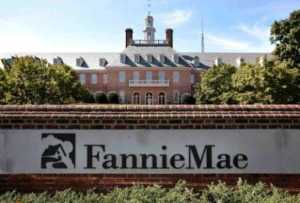
|
| Fannie Mae |
It's curious that the residents of such a town are a breed apart from the merchants in the nearby merchant strip. If the merchants of town life in that same town, there is much less conflict. More commonly, however, the merchants rent their commercial space and commute from distant places. That disenfranchises them from voting on school taxes and local ordinances and creates a merchantile mentality as contrasted with a resident community, dominated by high school students. One group wants lower taxes, the other group wants to get their kids into Harvard. One group wants space for customer parking, the other group is opposed to asphalt lots. And in particular, the residents want to avoid garish storefronts and abandoned strip malls. Since the only group which has an influence on both sides of this friction are the local real estate agents and landlords, their behavior is critical to the image of the town. When real estate interests are not residents of the town it is ominous, and they are well advised to remember that the sellers of houses are the ones who choose a real estate agent for a house turn-over. There's more to this dynamic than just that, but it's a good place to begin your analysis. Suburban real estate interests are constantly tempted to get into local politics, but politicians are the umpires in this game, and it soon becomes bad for their business if real estate agents potentially put their thumb on the scales.

|
| FHA Seal |
All politics is local, but all real estate is not entirely local. The present intrusion of the Federal Government into what is normally a purely local issue has become more pointed in the present real estate recession. Almost all mortgages are packaged and sensitized by "Fannie Mae and Freddy Mac". By overpaying for the mortgages they package, these two federal agencies are subsidizing the banks they buy the mortgages from. Or, that is half of the subsidy. The other half is the Federal Reserve, which presently lends money to banks at essentially zero interest. Acquiring free money from the "Fed", while selling mortgages to Fannie Mae at above-market rates, the federal government supports the banks at both ends. And that's not quite all; there is something called the FHA, Federal Housing Authority, which guarantees mortgages. Essentially an insurance policy, the FHA guarantee is issued for a cost to home buyers who meet standards set by Congress (for which, read Barney Frank and Chris Dodd). Although houses during the boom were selling for 18 times the estimated rental value, they are now selling for 15 times rental. FHA will insure such risks, but the banks won't lend more than the normal proportion, which is 12 times rental. Consequently, almost all mortgages are FHA insured, while the federal administration storms with a fury that the banks "won't lend". And indeed it begins to look as though banks will never issue uninsured mortgages until home prices fall another 25%. If home real estate prices do decline to a normal 12 times rental, a lot of people (i.e. voters) will be unhappy, and not just homeowners who bought at higher prices. The market is fairly screaming that you should sell your house and rent, but so far at least, these federal subsidies seem to be holding prices up. When normal pricing arrives, the recession is just about over, but it certainly won't feel that way if you are a seller.
Ageing Owners, Ageing Property
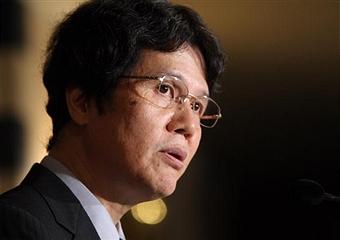
|
| Kiyohiko Nishimura |
Kiyohiko Nishimura is currently the Deputy Governor of the Bank of Japan (BOJ), and as such is expected to have wise things to say about finances, as indeed he does. Japan has a far older culture than the United States, and a botanical uniqueness growing out of the glaciers avoiding it, many thousands of years ago. But its latitude is approximately the same as ours, and its modern culture is affected by the deliberate effort of the Emperor to westernize the nation, following its "opening up" by our own Commodore Matthew Perry in 1852. Perhaps a more important relationship between the two cultures for present purposes is that Japan has been suffering from the current deep recession for fourteen years longer than we have. We don't want to repeat that performance, but we can certainly learn from it.
Mr. Nishimura lays great stress on the aging of the Japanese population because, in all nations, houses are mainly purchased by young newly-weds, and sold by that same generation years later as they prepare to retire. If a nation has an elderly population, it can expect a general lowering of house prices someday, reflecting too many sellers leaving the market at the same time. The buyers of those houses are competing with other young people, so the simultaneous bulges and dips of the population at later stages combine to have major effects on housing prices. At the moment, younger couples are having fewer children as a result of women postponing the first one. Nishimura goes on to reflect that something like the same is true of stocks and bonds, although at age levels five or ten years later. One implication is that retirement of our own World War II baby boom is about to depress American home prices, which will likely stay lower for 10-20 more years. Furthermore, our stock market will have a similar effect, stretching the depression out by as much as 5-15 years. The Japanese stock market has been a gloomy place to be during the past fifteen years, and by these lights might continue in the doldrums for another five or so. Meanwhile, our own situation predicts an additional generation of struggle while Japan is recovering. It's best not to apply these ideas too closely, of course, but surely somebody in our government ought to dig around in the data, at least telling us why we ain't goin' to repeat this pattern. Please.
Perhaps because they eat so much rice and fish, the Japanese already have a longer life expectancy than Americans do, but in terms of outliving your assets, that's not wholly advantageous, the way a love of golf might be. The best our nation might be able to do is to examine some of our premises about housing construction. In Kyoto, most houses were built with paper walls, for example.
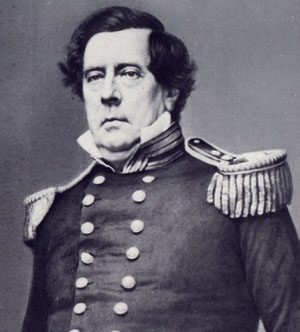
|
| Commodore Matthew Perry and Japan |
The house walls of the town of Kyoto were in fact made of waxed paper, which seems to work remarkably well. While no one now advocates going quite that far, we might think a second time about building the big hulking masonry houses so favored in our affluent suburbs. Such cumbersome building materials almost dictate custom building and strongly discourage mass production. How likely are such fortresses to survive in the real estate markets of fifty years from now? Judging from my home town, not too well. Haddonfield boasts it has been around since 1701, and there are at most three or four of its houses which have survived that long. We favor great hulking Victorian frame houses, with a good many bedrooms unoccupied, and high drafty ceilings, very large window openings and little original insulation. The heating arrangements have gone from fireplaces to coal furnaces, to oil, and lately to natural gas. The meter reader who checks my consumption every month tells me that almost all the houses now have gas heat, so almost all the houses are using their second or third heating plant, along with their eighth or tenth roof, and thirty coats of paint. This kind of maintenance is not prohibitively expensive, but just wait until the plumbing starts to go, and leak, and freeze, with attendant plastering, carpentry, and painting. Our schools and transportation are excellent, so we have location, location, location. But when the plumbing, heating, and roofing start to require financial infusions all at once, you get tear-downs. A tear-down is a new house in which a specialist builder buys the old house, tears it down, and looks for a buyer to commission the new house on an old plot of land. Right now, there appear to be six or eight such Haddonfield houses, torn down and looking for a buyer to commission a new house on that location, location. If we repeat the Japanese experience, there will be some unhappy people, somewhere. And that will include the neighbors like me, who generally do not relish languishing vacant lots next door, but fear what the new one will be like.
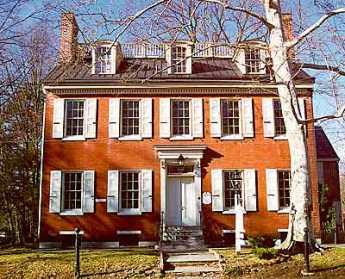
|
| Greenfield Hall |
The thought has to occur to somebody that building the whole town of less substantial materials in the first place would be worth investigation, replacing the houses every forty years when the major stuff wears out. At the present, when a town of several thousand houses has five or six tear-downs, the neighbors would not tolerate replacing tear-downs with insubstantial cardboard boxes. Seeing what has happened to inner-city school systems, the neighbors would be uneasy about "affordable housing" built in place of stately old Homes of Pride. In time, that might lead to a deterioration of one of the two pillars of location, location -- the schools -- and hence to a massive loss of asset value. And yet when those houses empty out the school children, leaving only retirees in place, the schools will not be worth much to the owners or in time to anybody else. There's an unfortunate tendency for local political control to migrate into the hands of local real estate brokers, so you had better be sure any bright new proposal is tightly buttressed with facts.
The only real hope for evolution in this obsolete system may lie in the schools of architecture, strengthened perhaps by some research grants. Countless World Fairs have displayed the proud products of their imaginative thinking, but mostly to no avail. Perhaps the ideas are not yet ripe, but since it would take more than a generation to create a useful demonstration project of whatever does become ripe for decision, let's start thinking about some innovative suburban designs, right now.
Ms. Mayor

|
| Mayor Letitia Colombi |
One of the great treasures of Haddonfield is a letter from Benjamin Franklin to the husband of Elizabeth Haddon, to the effect that she was the most forceful woman of the region. Indeed, it is part of the tradition of the Haddonfield Meeting of Friends that the men's meeting and the women's meeting met is separate rooms and kept separate minutes at that time. Elizabeth was the clerk of the women's meeting, and while the men's meeting would sign the minutes as "The Meeting on Stoy's Landing" or the "Meeting near Cooper's Creek" or something else topical, the minutes of the women's meeting were consistently signed in a single way. They were from the meeting in Haddonfield. Ultimately, everybody gave up and named the town Haddonfield.
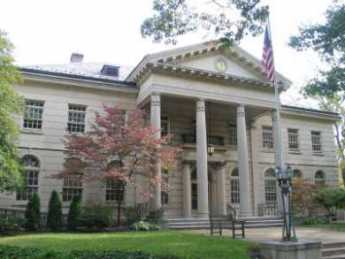
|
| Haddonfield Borough Hall |
Without being able to recall a single other woman who was Mayor of the town, it does seem appropriate that its present mayor is a lady and a forceful one at that. Letitia Colombia has been on the Borough Board of Commissioners for nearly twenty years and seems likely to remain Mayor for as long as she wishes. In the tradition of forcefulness, a number of old timers in the town remember when she first got elected by knocking on every door in the town, and then marched down the main street in the July 4th parade, wearing high-heeled red shoes.
The Right Angle Club was curious to see what this was all about, and her performance was a brilliant demonstration why politics is a full-time sport of every town in Texas. Odessa, her home town, is a few miles from Midland-where-the-oil-comes from, and she and Laura Bush probably attended the same high school. They are certainly both members of the same school.
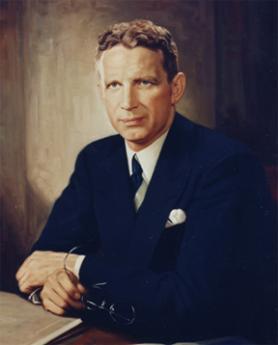
|
| Al Driscoll |
In many ways it was Al Driscoll who as Mayor asked why Haddonfield couldn't be like Princeton, where he once went to school. The answer he got was to change the zoning ordinances and then just wait thirty years. It worked fairly well, although Haddonfield got a parking and traffic problem along with the good features of looking like Princeton. But it wasn't Tish's way; one might say it wasn't the Texas way. She hired some consultants at a cost of $125,000 to work out a detailed plan for changing Haddonfield for the better, and then followed the plan. It included a list of the kind of stores you do and don't want in a town of this type and the general strategy of attracting them. The zoning laws are sort of like Princeton's, but different enough to matter. Year by year, you can see the town change from a sleepy little place into a lively place to be. There are no empty lots in Haddonfield; to change the town, you have to remodel everything, house by house. On a summer evening, there are throngs of people on the sidewalks downtown, entertained by three or four street bands, wandering up and down at the sidewalk sales of the merchants. Haddonfield is "dry" in the sense that liquor sales are prohibited; that policy was recently reconfirmed by a four-to-one vote. But it hasn't kept restaurants away. The residents like BYOB a lot, and fully understand what it means.
Taxes in Haddonfield are, well, generous. But Haddonfield gets no state school aid; its schools are much like a thirty-million-dollar private school system, run by locals to local taste. And a quarter of our taxes go to Camden County. Tish boldly announces we get nothing whatever for those taxes in return. With a slogan like that, it's pretty hard to doubt she's a Republican.
REFERENCES
| Heroines of Haddonfield 1713-2013: Christie Castorino: ISBN: 978-1-4836-2719-9 | Xliris |
Fisher on TV

|
| Governor Chris Christie |
As I was rushing out of my office tonight, trying not to be late for a gathering of constituents, I was suddenly confronted by a nice young lady holding a piece of paper, closely followed by a young man with a big professional TV camera. I like to think they were lying in wait for me, but more likely they were haunting the Starbucks across the street.
The question was fired at me, what did I think about Governor Christie using the Supreme Court about gay marriage? I had to admit I don't watch TV all day long, so I hadn't heard about it. Well, do you think it is appropriate for the Governor of a state to sue the Supreme Court? Huh, do you? Caught totally by surprise by a question I don't know much about, I answered, or mumbled, that it seemed to be a lawyer's question, and I'm not a lawyer. I do know that the U.S. Supreme Court will refuse to take a case unless the plaintiff can show he has sustained a personal loss of some sort. But I don't know anything about the New Jersey Supreme Court or its rules, and the whole thing seems to me to be above my pay grade. Or something like that.
If I had had more than ten seconds to think about it, I might have said, "What you really are asking me is Don't you think Christie is a bad, insensitive person?" And my answer to that question if put a little more plainly, would be, "No, I like Governor Christie a lot and I trust a former U.S. Attorney to know the fine points of law better than I do, so I support him."
And if I am wrong, and the real question you are asking me is Am I gay? Then, my answer would be, "No, I'm not gay one bit. But I am inclined to let other people do as they please, as long as it is harmless to others."
And if the hidden question is do I approve of people being gay, I would have to answer that if everybody became gay, it's pretty hard to see how the human race would survive. Now could I ask you a question? Who are you, and who is paying you to ask me slanted questions?
Follow-up, written the next day: The next day's newspaper gave an entirely new slant to this little episode. It seems the decision was made by the Superior Court, not the Supreme Court, and Governor Christie appealed the decision, he did not sue anybody. So the whole interview process was a put-up job, slanting the attention away from a record-breaking court decision to Governor Christie, who was dutifully responding to a Superior Court ruling which overturned a state law. All the rest of it was either intended to shift attention or else to tangle me up in a confused reaction to some events which did not happen at all.
In that case, let me state my central position. Governor Christie is a great guy, who definitely needs to win re-election November 5. And I am running for the role of Assemblyman for the 6th District, prepared to help him in every way I can.
Minimum Wage Fangdoodle

|
| Governor Chris Christie |
The November 2013 elections have been widely accepted to be a spectacular win for New Jersey Governor Chris Christie, suddenly making him a presidential front-runner for 2016. The only other significant election was a close win in the Virginia gubernatorial race for a fund-raising crony of Bill Clinton over the Attorney General who started the Supreme Court Case over Obamacare. In the view of the news media, there were only two elections in this off-year -- a landslide in New Jersey, and a dead heat in Virginia, for Governor.
Well, as a matter of fact, there was also an election in New Jersey for all of the members of the legislature, which means that I was running against the Democratic majority leader in the 6th Legislative District. I got 19,000 votes, but I needed more to win. At least in my family, it was a big event, particularly since no one else in New Jersey contributed a dime to my campaign, and while Governor Christie may have whispered a few encouraging words to me, there was no evidence of his assistance. But you can forget about that, too, because this election was really about the minimum wage.
The first inkling I got that something was up was receiving a sample ballot, three days before the election, where there was a referendum question about the minimum wage that no one had told me about, although it could scarcely have been a secret to get it on the ballot. And secondly, on election day there was scarcely any evidence of campaigning for Democrat candidates except for a few yard signs, but literally, dozens of campaign workers poured into the subway stations, handing out great volumes of campaign literature about the minimum wage. Even that went past me unnoticed, because who in the world would vote for a proposal which would increase unemployment during a severe recession? When I expressed the same sentiment to my Democratic friends, I was surprised to discover they all knew about it in advance. In retrospect, that was a fairly good indication that the Internet had selectively urged support of this proposition to the party faithful, but had not said one word in campaigning for it. It won endorsement by a heavy margin, as things soon turned out. What's worse, what had been endorsed by referendum had been to amend the constitution to this effect, automatically indexing it to the cost of living. It's going to be pretty hard to reverse that since all constitutions have been written to make it very hard to amend them.
p> In the week after the election, I notice that several other states have been considering raising the minimum wage. An article appeared on the editorial page of the New York Times arguing that research showed there was no evidence that raising the minimum wage caused unemployment, and a few days later, Paul Krugman had a learned column on the Times editorial page to the effect that smart people all knew there was no reason to expect unemployment from raising the minimum wage, and only the hopelessly ignorant rubes would imagine there was reason to think so. Having spent some time with editorial writers, it seemed pretty evident to me that there was a nationally coordinated effort to convert this into a truism, accepted so widely it would be futile to argue against it. When it is also possible to see the existence of a campaign to impose a maximum wage (and not merely in Switzerland, where it was defeated on a ballot), the trajectory of a rising minimum wage meeting a falling maximum wage easily led to conjectures that what was really afoot was a campaign to take wages out of the marketplace. Or was that really the goal?

|
| Ben Bernanke |
For months, the Federal Reserve Chairman has been emphasizing that the Fed must obey two mandates: to maintain price stability and to minimize unemployment. Meanwhile, the dirty little secret among economists has been that unemployment is the main obstacle to inflation in the face of a massive enlargement of the money supply. Unemployment is currently at 7.1% and falling, while the Fed has lifted the veil of "transparency" to reveal it made a promise in double-speak to start selling some of the bonds it issued to combat the recession when unemployment reaches 6.5%. As time has gone on, Mr. Bernanke has seemed to back away from that promise. He is not so sure that unemployment is a good measure of unemployment, other measures may be a better measure of what we are driving at. He never meant to start selling bonds when unemployment reached 6.5%, he only meant that he might reduce the number he planned to buy. He never meant to make a promise, he only was being transparent about the current thinking of the Board. And anyway, Janet Yellen will take over his job in a month, so you can't very well bind your successor to do anything at all. What's this tap-dancing all about?
Well, it simply won't do, to suggest that the Federal Reserve isn't as independent of politics as it pretends to be. But everyone noticed that the stock market had a bad fainting spell when he suggested a few months ago that the Board had been discussing the matter; just imagine what it would do if he actually made a promise to act, let alone actually taking an action. By itself, such an announcement would probably send interest rates on a rise toward normal levels. The stock market mostly anticipates the future, so it would jump ahead of whatever action was taken. Since the United States is now the largest debtor on earth, a rise of interest rates would immediately add huge amounts to the current deficit and the projected national debt. The stock market would almost surely drop, possibly severely, in response to such commotion in the debt markets. And the national economy would certainly feel the deflationary effect of such activity in the financial markets, sending markets even lower. Fear of such a reaction would surely persist longer than the real need for monetary easing, making the resultant inflation even worse than it had to be.
 Is it possible the Obama Administration prefers a little extra unemployment, to risking a stock market crash before a coming election? 
|
| Minimum Wage Uproar |
In an era of desperate experimentation with the simultaneous solutions of several problems at once, perhaps the best conservative response to this paper is to seek ways to relax its inflexibility. The political process, particularly the amendment of state constitutions, is a lengthy and cumbersome impediment to agile management of the economy. It is fairly unlikely that a secret springing of a referendum trap can be repeated. The greater risk is that we will know what should be done, but become unable to do it quickly.
Meanwhile, the politicians are designing things and politicians like things simple. The Republican solution is to pass a minimum wage, but keep its benefit slightly below the entry-level wage; they get credit for passing it, but it has almost no applicability. The Democrat approach is to make a big noise about passing a meaningless bill, promising they will make it up with off the balance sheet entitlements, like health care and college tuition. Either way, usually nothing much happens after the election is over.
| Posted by: brendan worsfold | May 9, 2017 12:02 PM |
| Posted by: Steve Warner | Feb 13, 2010 5:51 PM |
| Posted by: Edel | Feb 2, 2010 8:47 AM |
Heart attack description spooky, but instructive. Hope you continue to enjoy good health
| Posted by: Bill Reynolds | Jan 24, 2010 1:41 PM |
| Posted by: Mikle | Dec 8, 2009 5:51 AM |
24 Blogs
The Origins of Haddonfield
 Haddonfield was founded by a 19-year-old Quaker girl in 1701 when it was still a fairly dangerous place to walk around. She has over 140 direct descendants, and forty of them still live in the town. Some famous scenes from the Revolutionary War took place here.
Haddonfield was founded by a 19-year-old Quaker girl in 1701 when it was still a fairly dangerous place to walk around. She has over 140 direct descendants, and forty of them still live in the town. Some famous scenes from the Revolutionary War took place here.
Camden NJ: The Third, or Irish, Tenth
 Early settlers of the Delaware Bay, generally picked the eastern, now New Jersey, side of the river because the terrain was easier to farm. In time, the vast wilderness on the western, or Pennsylvania, side led to more commerce.
Early settlers of the Delaware Bay, generally picked the eastern, now New Jersey, side of the river because the terrain was easier to farm. In time, the vast wilderness on the western, or Pennsylvania, side led to more commerce.
Railroading Haddonfield
 Steam engines puffed through the center of Haddonfield, not so long ago.
Steam engines puffed through the center of Haddonfield, not so long ago.
Norcross
New blog 2019-05-21 00:54:26 description
Tavistock
 A town with only four houses shows you what can be done when you really need to play golf.
A town with only four houses shows you what can be done when you really need to play golf.
The Empire Visits Haddonfield, Briefly
 All religions were welcomed and tolerated, but the English government was deathly fearful of French Catholics in Canada, and Spanish Catholics in Florida. The Stuart kings were Catholic, sort of, but the important issue was protecting colonial real estate more than protecting doctrinal purity.
All religions were welcomed and tolerated, but the English government was deathly fearful of French Catholics in Canada, and Spanish Catholics in Florida. The Stuart kings were Catholic, sort of, but the important issue was protecting colonial real estate more than protecting doctrinal purity.
Wildlife in Haddonfield
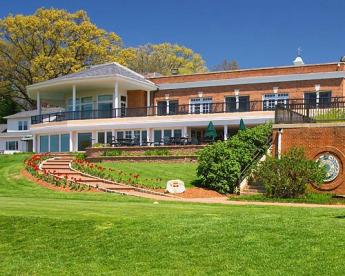 Haddonfield looks like a carefully manicured suburb but there is a surprising amount of wildlife if you know how to look for it.
Haddonfield looks like a carefully manicured suburb but there is a surprising amount of wildlife if you know how to look for it.
Haddonfield Blooming Outdoors, Year-Round

Geckos: Academy of Natural Sciences brings Mini Dinosaurs
 Philadelphia's Academy of Natural Sciences introduced the world to dinosaurs, and now introduces us to a miniature version.
Philadelphia's Academy of Natural Sciences introduced the world to dinosaurs, and now introduces us to a miniature version.
What To Do If You Have a Heart Attack
 In May, I had a coronary occlusion, and a fast trip to the Pennsylvania Hospital. Cardiac catheterization opened the artery with a stent before there was time for infarction.
In May, I had a coronary occlusion, and a fast trip to the Pennsylvania Hospital. Cardiac catheterization opened the artery with a stent before there was time for infarction.
Plays and Players, Haddonfield Version
 This year the Haddonfield Plays and Players celebrate their 75th anniversary, with an outstanding production of Anything Goes, by Cole Porter Y'13.
This year the Haddonfield Plays and Players celebrate their 75th anniversary, with an outstanding production of Anything Goes, by Cole Porter Y'13.
The King's Road
 It's only been performed fifteen or twenty times, but Hayyr Kaufman's musical comedy captures the real spirit of Olde Haddonfield.
It's only been performed fifteen or twenty times, but Hayyr Kaufman's musical comedy captures the real spirit of Olde Haddonfield.
Quaker Carillon
 In an unprogrammed Quaker meeting, respectful pauses between messages should be long enough to form a "gathered opinion". Not too long, of course, or lacking some external signal of what the subject is. Gathered meetings and fragmented ones may sound alike to strangers, but little signals that others are listening can be found in the intervals of silence.
In an unprogrammed Quaker meeting, respectful pauses between messages should be long enough to form a "gathered opinion". Not too long, of course, or lacking some external signal of what the subject is. Gathered meetings and fragmented ones may sound alike to strangers, but little signals that others are listening can be found in the intervals of silence.
George Willoughby, 95, Peace Activist
 In The Philadelphia Inquirer for February 4, 2010, By Claudia Vargas Inquirer Writer.
In The Philadelphia Inquirer for February 4, 2010, By Claudia Vargas Inquirer Writer.
Inazo Nitobe, Quaker Samurai
 One of the most revered leaders of modern Japan was a converted Samurai, married to a Philadelphia Quaker. His father was an advisor to the Emperor, a family of famous warriors.
One of the most revered leaders of modern Japan was a converted Samurai, married to a Philadelphia Quaker. His father was an advisor to the Emperor, a family of famous warriors.
School Tax Seldom Equates to School Spending
 Voting today on school budgets, local districts in New Jersey do not seem to realize how poorly school spending correlates with school tax rates.
Voting today on school budgets, local districts in New Jersey do not seem to realize how poorly school spending correlates with school tax rates.
How Does New Jersey State Aid Affect School Districts?
 State aid for schools is like health insurance: costs go up faster when you aren't spending your own money. At least, that's what the New Jersey statistics seem to show.
State aid for schools is like health insurance: costs go up faster when you aren't spending your own money. At least, that's what the New Jersey statistics seem to show.
Special Education, Special Problems
 Until recently, mentally retarded children weren't even considered in school budgets. But in recent decades, they have become one of the biggest challenges.
Until recently, mentally retarded children weren't even considered in school budgets. But in recent decades, they have become one of the biggest challenges.
Selling Entire Towns
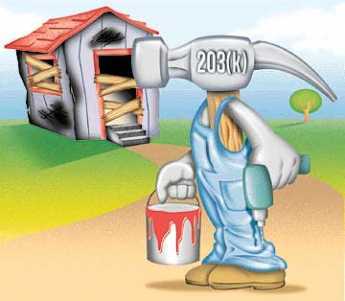 Some builders build whole towns without houses and then sell them to custom home builders.
Some builders build whole towns without houses and then sell them to custom home builders.
Ageing Owners, Ageing Property
 From Japan, we get a fresh view of our assets. Kiyohiko Nishimura observes that the price of a house, even of a stock portfolio, has something to do with the age of the owner who is selling it.
From Japan, we get a fresh view of our assets. Kiyohiko Nishimura observes that the price of a house, even of a stock portfolio, has something to do with the age of the owner who is selling it.
Ms. Mayor
 The current, and long time, Mayor of Haddonfield New Jersey is a lady from Odessa, Texas.
The current, and long time, Mayor of Haddonfield New Jersey is a lady from Odessa, Texas.
Fisher on TV
 They stop you on the street with a movie camera, these days.
They stop you on the street with a movie camera, these days.
Minimum Wage Fangdoodle
 While no one was looking, mandating a minimum wage turned into a contrivance to maintain low-interest rates.
While no one was looking, mandating a minimum wage turned into a contrivance to maintain low-interest rates.